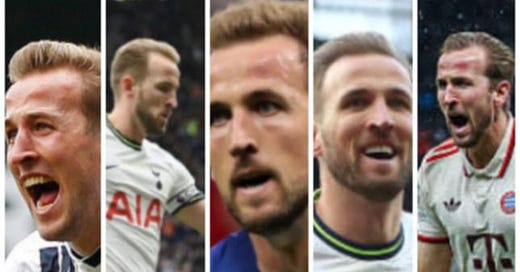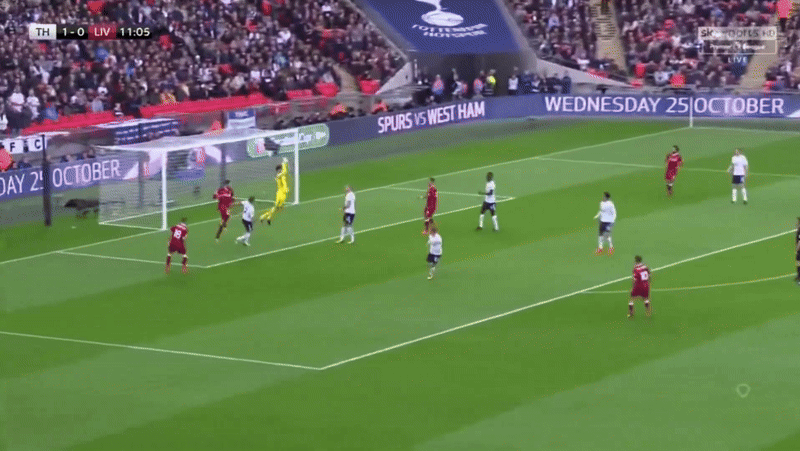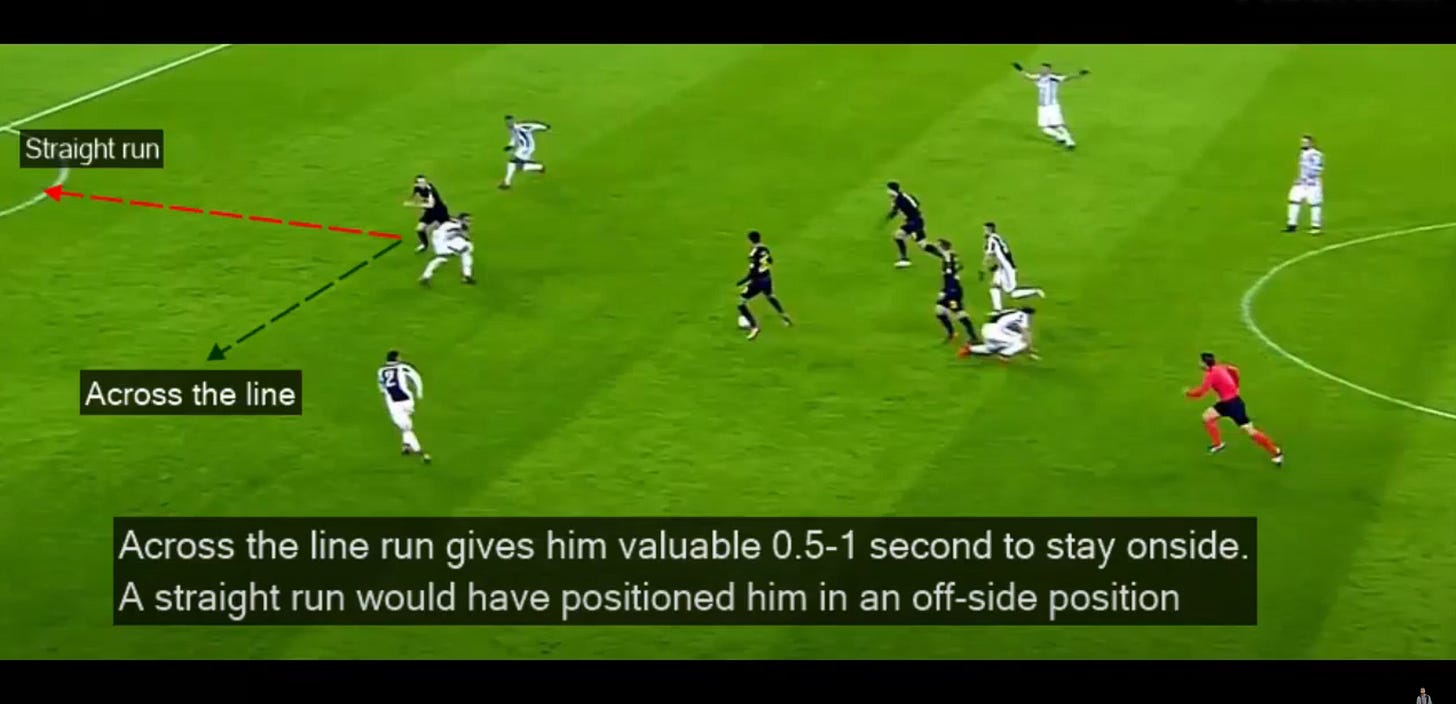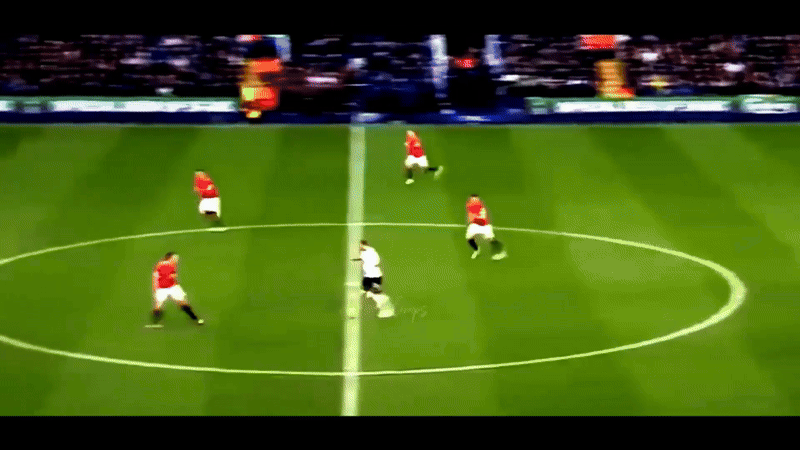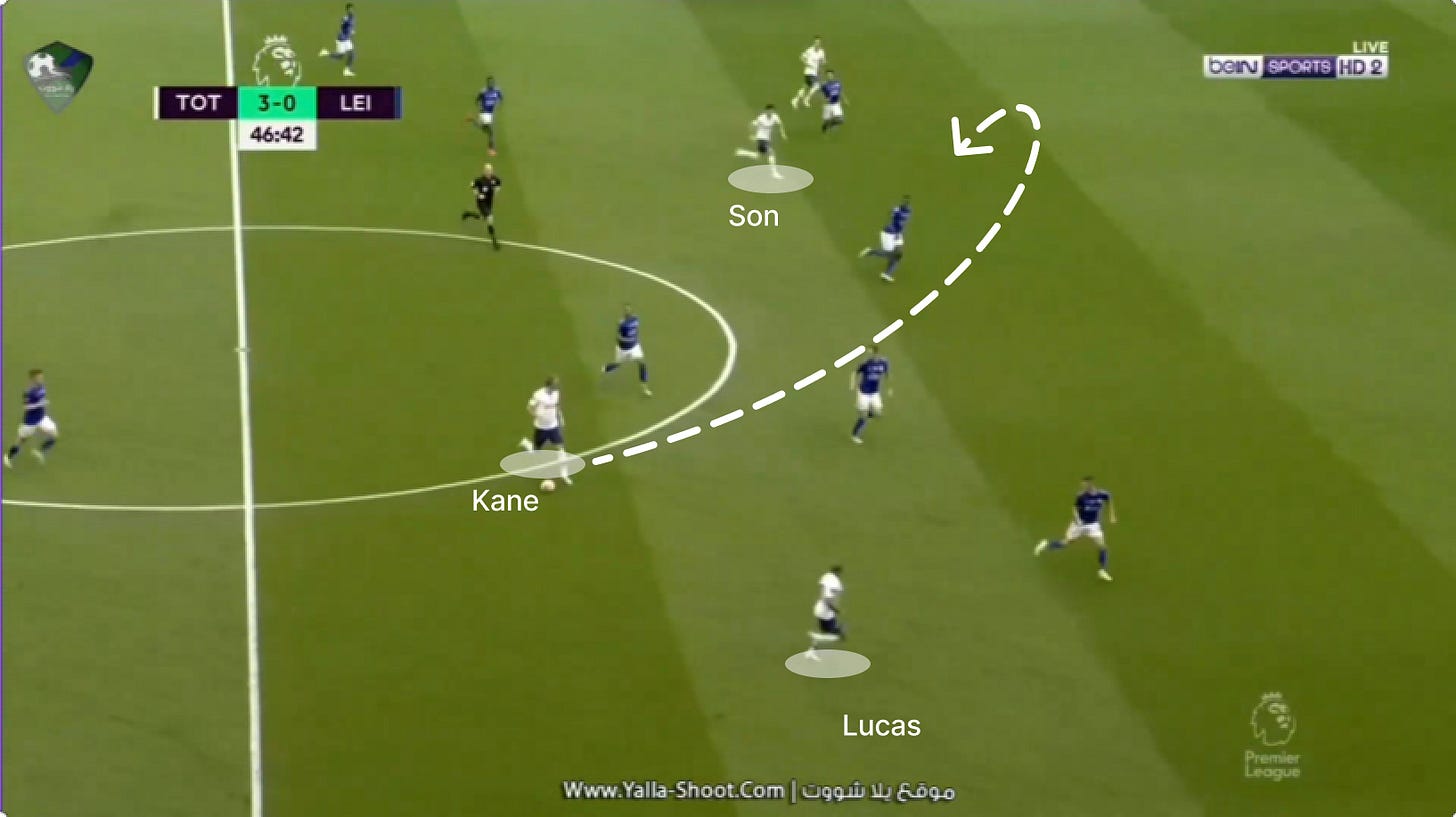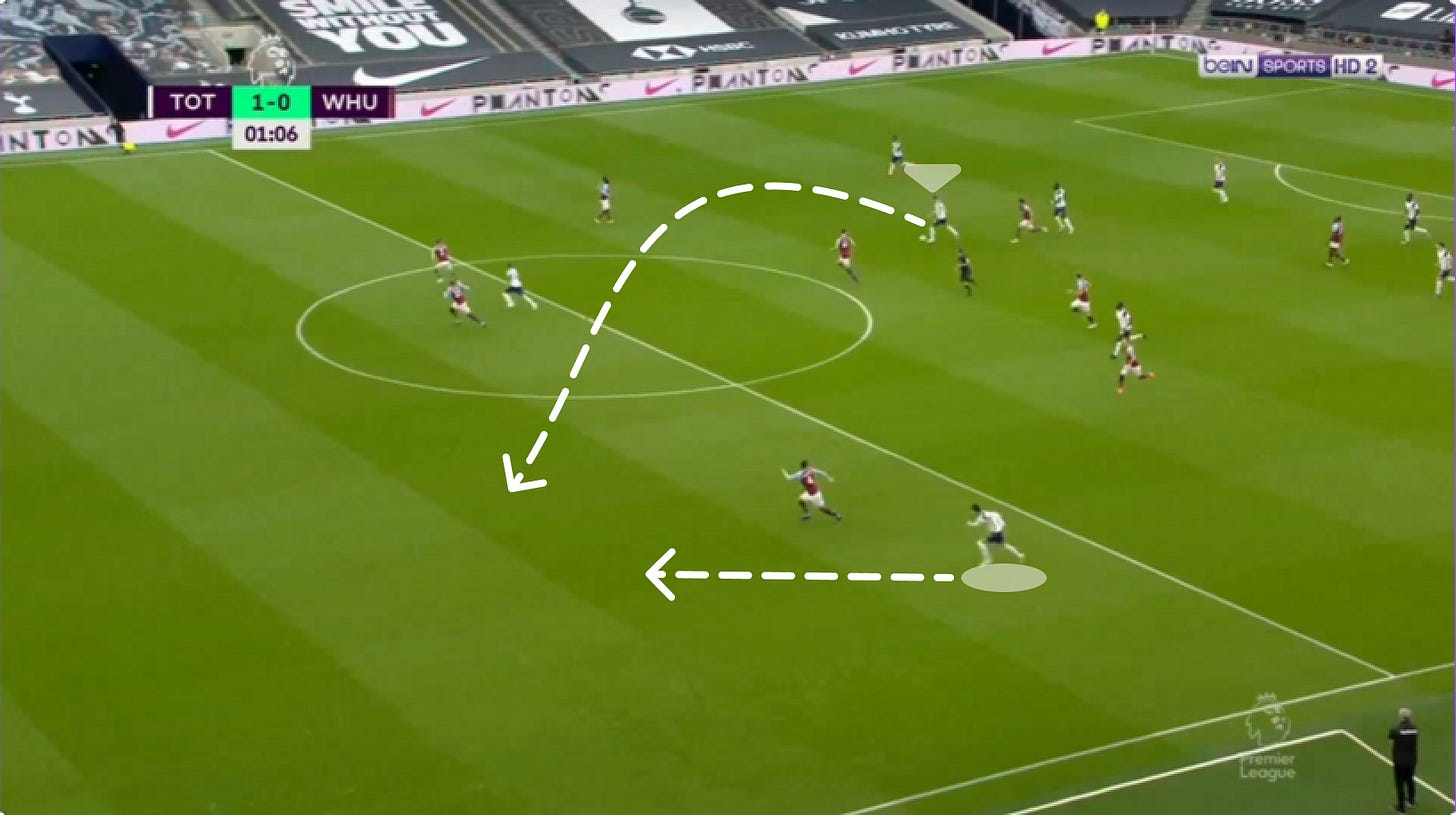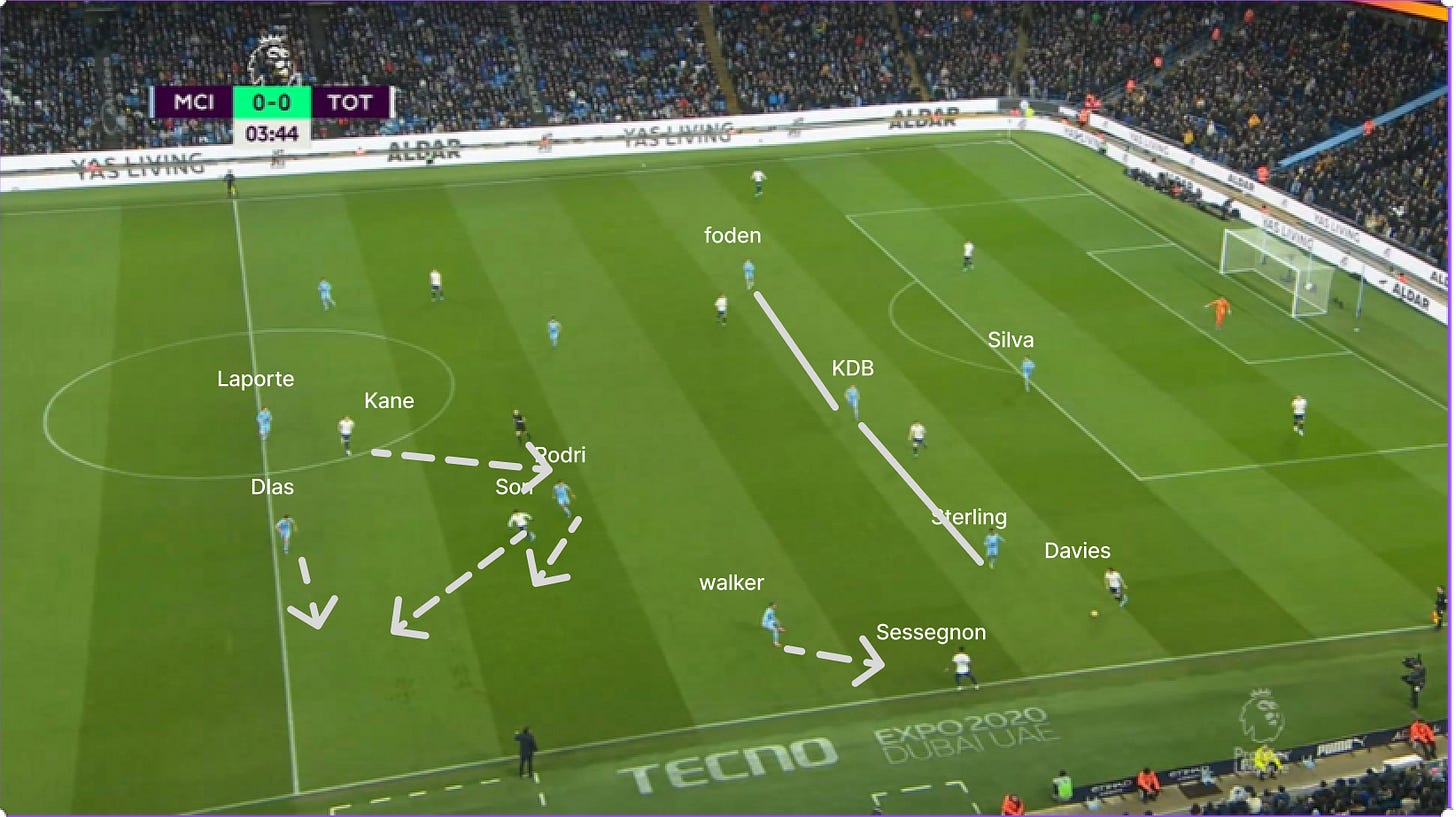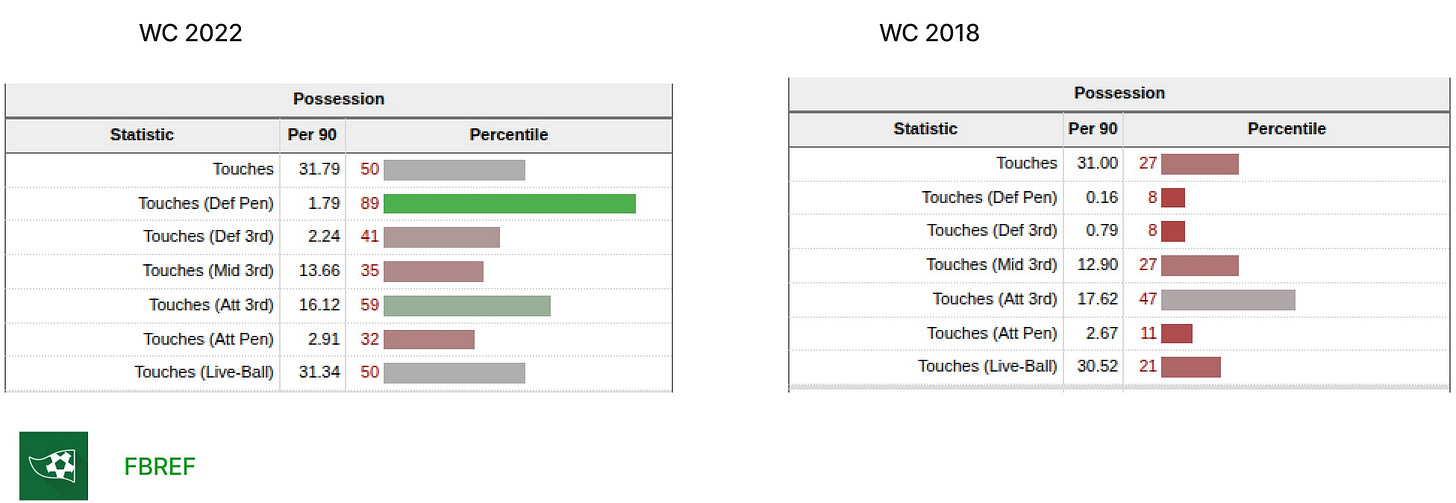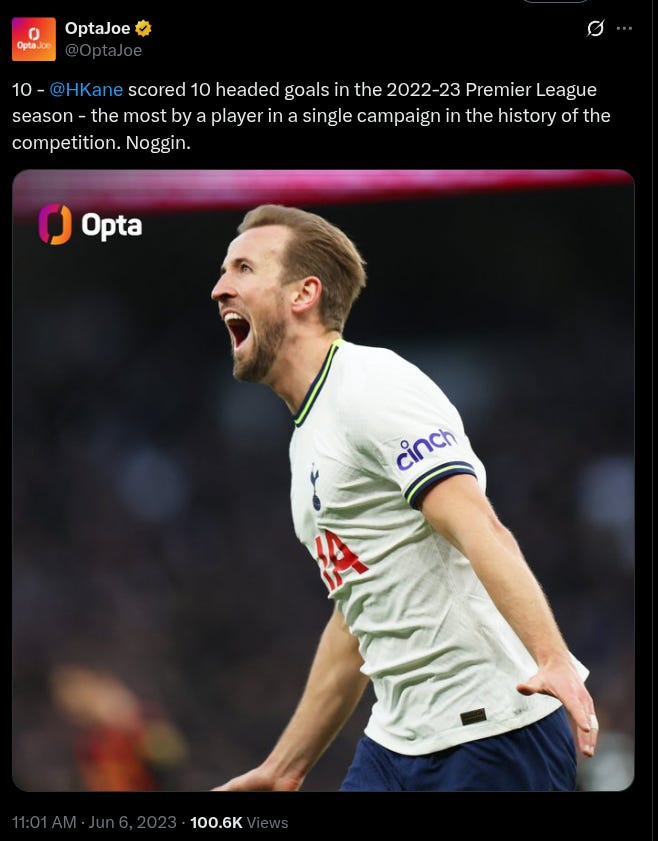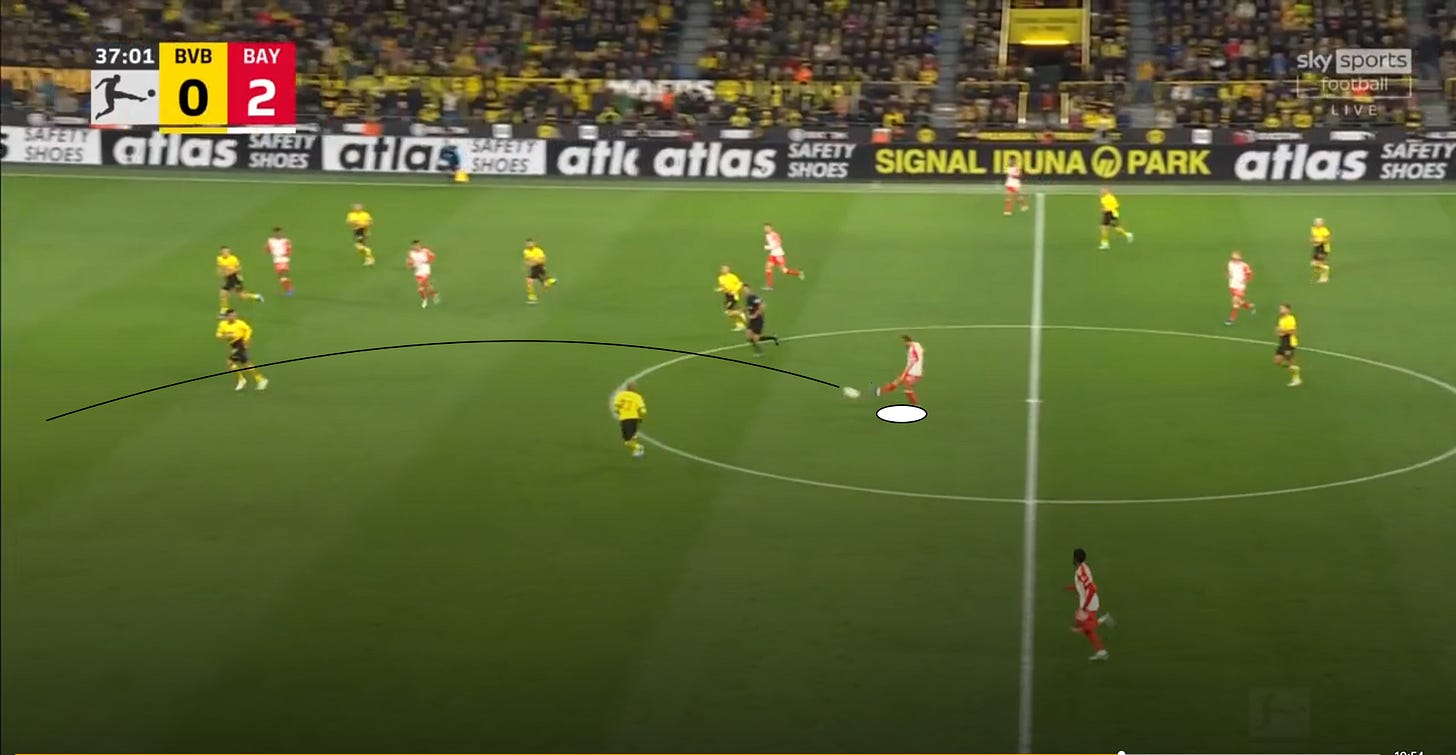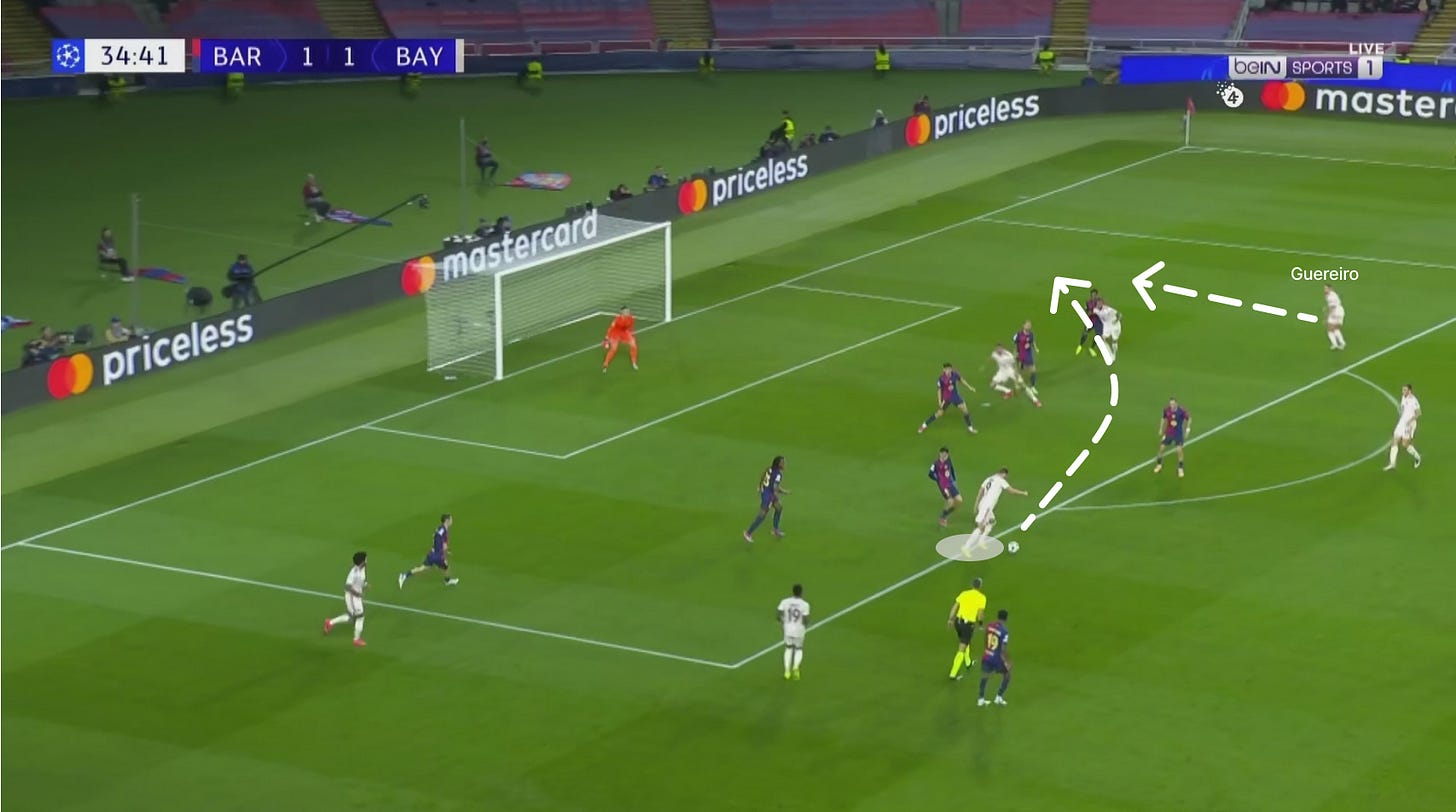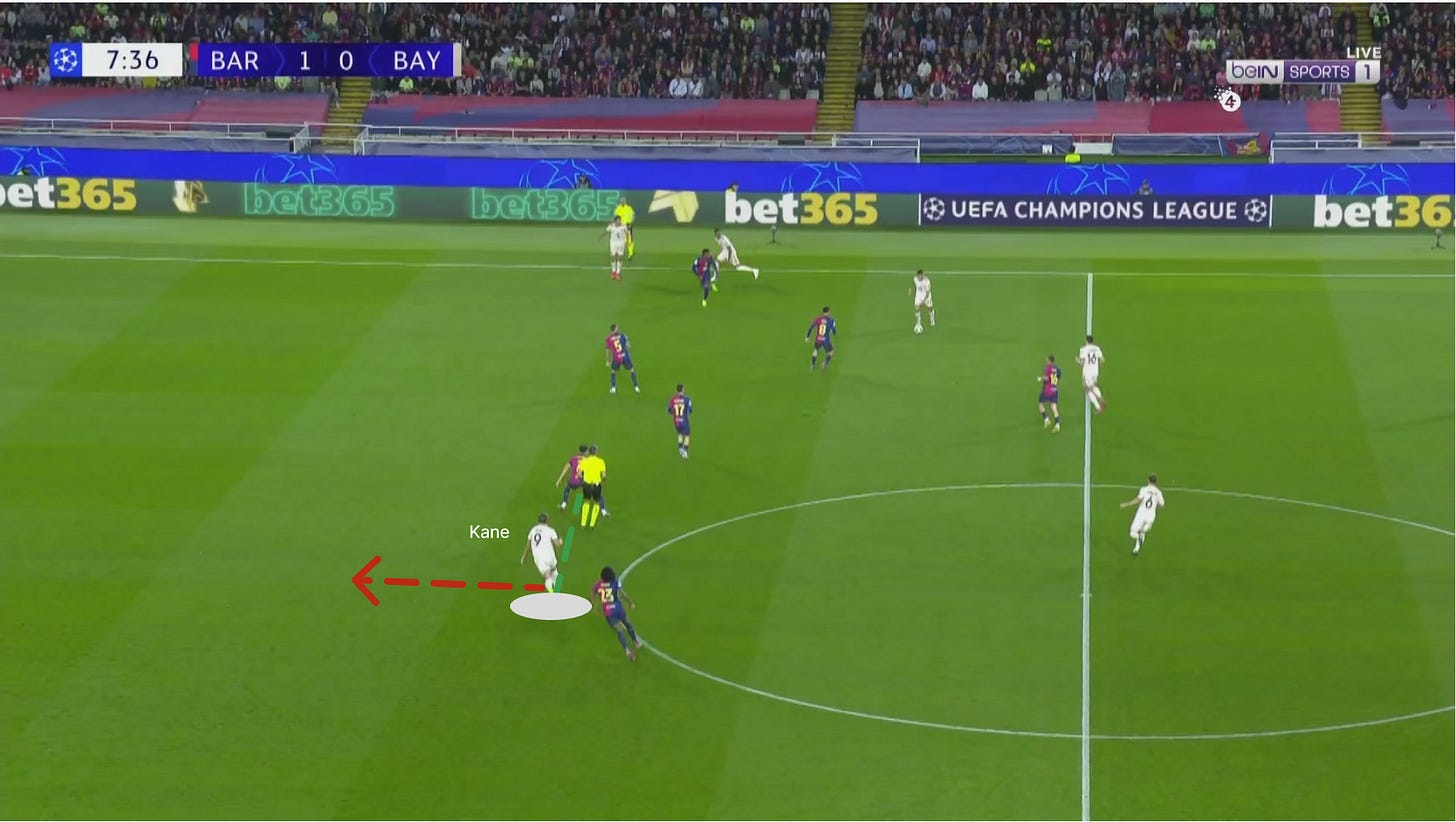Harry Kane’s Odyssey: When the Beautiful Game Betrayed Its Greatest Striker
This article was written in March 2025, but its publication was delayed for personal reasons.
Every great man eventually finds himself between the pages of a book, the lines of an article, or the frames of a video tribute by another man... And this article is a tribute to the golden career of Harry Kane — a career gilded with brilliance, yet untouched by gold.
Harry Kane might finally win his first title as a football player this season, putting an end to one of the overused trends on social media. But before he is crowned, I’ll take the opportunity to talk about the greatest striker I’ve ever seen and one of the best players in the world over the last decade.
The making of the perfect number 9, the ruthless striker:
I never imagined that a striker wearing the number 18 shirt, playing against Chelsea—the Premier League champions at the time—would become the best striker I’ve ever seen since I started watching football. I remember that match vividly: it was at White Hart Lane—or as some Spurs fans fondly call it, White Hart Kane. Chelsea, led by Mourinho and spearheaded by the fierce Diego Costa, were clear favorites. But then came Harry Kane, stealing the spotlight with two goals past Courtois and declaring himself the man of the night.
I was 13 years old at the time, repeating to myself: "Wow! Who is this player?" I immediately rushed to open the famous game “PES 2013”. I edited the Tottenham squad and added a player named Harry Kane. Wow... look what football can do to a young kid.
To truly appreciate the brilliance of that goal, you have to break it down: the first touch under pressure, the intelligent movement into space, the slick dribble, ball protection with remarkable composure, and finally—a shot taken against the direction of his body with typical precision, Wow. Honestly—just wow.
The 2014/2015 season ended on a high for the Englishman. It marked the beginning of a wave of individual achievements that keep flowing. He was named the Premier League’s Young Player of the Year, earned his first England national team call-up, and finished as the league’s second-highest scorer—surpassing none other than Diego Costa, who had delivered one of the finest striking seasons in Chelsea history. To this day, Blues fans still long for a striker of Costa’s caliber.
Harry Kane scored his first goal for England against Lithuania just 80 seconds after coming onto the pitch.
2015/2016: From Youthful No.18 to the Mature No.10
With the switch from shirt number 18 to the iconic number 10, everything began to change. he was as if a beast had been unleashed—Kane was no longer just a promising youngster; he was transforming into one of the best strikers in the world. His legendary goal against Arsenal was a defining moment, a signal to everyone that a new force had arrived—one capable of shaking the throne of the game’s elite forwards.
That season, Tottenham—at least in my opinion—were the closest challengers to Leicester’s miracle run. Tactically, they were the most complete side on the pitch. But as Pep Guardiola once said, “Football is only 30% tactics.”
Despite missing out on the title, Kane finished the campaign as the Premier League’s top scorer, beating both Jamie Vardy and Sergio Agüero in the race for the Golden Boot.
These images show his clever movement behind defenders and his ability to position himself perfectly as a finisher
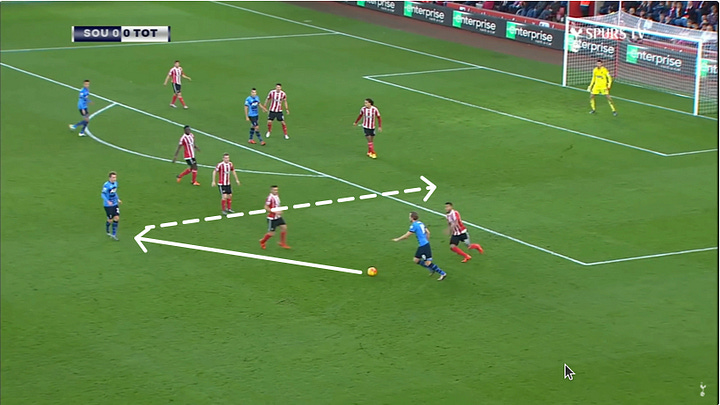

The following images showcase Kane’s intelligence and cunning body feint to escape the defender. He begins the move by making a run and passing the ball into space for Walker. Then, he positions himself around the edge of the box — you can see his hand gesture, clearly calling for the ball. Kane places Elneny behind him, deceiving him with a body movement that suggests he’ll move right, only to shift left instead, putting himself in a perfect shooting position. This moment illustrates his brilliance as a striker — creating chances out of nothing and fully capitalizing on his skillset.

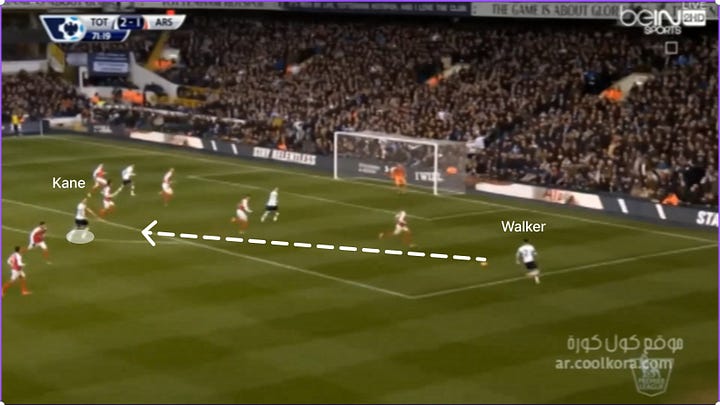


2016/2017: Premier League Top Scorer for the Second Consecutive Season
This season wasn’t just a continuation of Harry Kane’s brilliance—it was extraordinary. A season that truly cemented his place among the world’s elite goal scorers. Kane netted an astonishing 29 goals in just 30 Premier League matches—and if you haven’t seen them all, I highly recommend it. The variety and quality of those goals (1) are simply incredible.It was a terrifying display of attacking power—goals from every angle and situation. Kane ended the calendar year (2017) with a record 39 Premier League goals, the most ever scored in a single calendar year.
Kane often scores with his first touch, but he also excels at receiving the ball at his feet and driving toward goal. Despite his strong build, he’s surprisingly agile and capable of beating defenders one-on-one—as shown in his goal against Southampton.
Defenders frequently try to force him onto his left foot, but that strategy rarely works. In fact, Kane holds the record for the most Premier League goals scored with a weaker foot (41 goals)—a testament to his two-footed ability and clinical finishing.
Pictures taken from (2)
Kane’s fourth goal against West Bromwich Albion—completing his hat-trick—was a masterclass in elite forward play. He started the attack by playing a pass to Dele Alli, then immediately made a run into the open space. Alli responded with a perfectly weighted lofted ball over the defender, which Kane converted into a brilliant goal.
This goal showcased every attribute of a top-class striker: intelligent movement into space, His awareness through reading the situation and anticipating defenders movements, a clear call for the ball, and—of course—his trademark clinical finish.
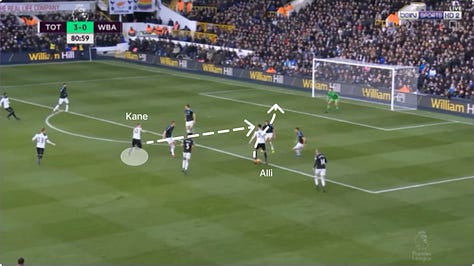
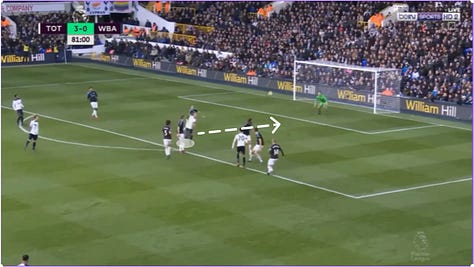

Despite missing eight matches due to injury, the Englishman still claimed the Premier League Golden Boot for the second consecutive season, becoming the youngest player to win it back-to-back since World War II. Tottenham ended the season as the league’s top scorers and also conceded the fewest goals .Yet, as is often the case with Spurs, dazzling performances and a well-drilled squad weren’t enough—luck was once again not on their side. This was arguably Tottenham’s best version under Mauricio Pochettino, a team that thrilled neutrals but fell just short of silverware.
2017/2018: Relentless Consistency and a Champions League Breakthrough
By this point, Harry Kane had firmly established himself as a world-class striker. The 2017/2018 season marked the fourth consecutive campaign in which he broke the 20-goal barrier in the Premier League under Mauricio Pochettino—making him the only striker in Tottenham’s history to achieve such a feat.
To put that into perspective: formers Spurs forwards like Dimitar Berbatov, Jermain Defoe, and Robbie Keane typically scored between 10 and 12 league goals per season. Kane, in contrast, amassed 105 league goals across those four seasons, with just 14 of them coming from the penalty spot.
He was becoming the closest thing to the complete centre-forward. Kane had no obvious weaknesses—he could score from any situation and in every possible way. His ball retention and control was excellent, his work rate tireless, but it was his clinical finishing that truly set him apart.
Kane possesses an almost flawless striking technique. He passes the ball into the net with both feet, often with precision that finds the corners. His aerial ability is also outstanding, consistently ranking among the top scorers of headed goals in the Premier League.
His versatility makes him a nightmare for defenders—he’s a threat from distance, inside the box, in the air, and with either foot. Simply put, there’s no easy way to contain Harry Kane.
Photos taken from The Athletic(3)
the iconic goal against Liverpool showcased his IQ, sharp decision-making, and ability to use his body positioning to perfectly suit the situation.
In addition to delivering another stunning Premier League campaign—his fourth in a row—in which he scored 30 goals, Harry Kane lose the Golden Boot, this time to Mohamed Salah. Remarkably, Kane became the first player in history to lose the PL Golden Boot twice after scoring 30 goals in a single season—the second instance would come in 2023, edged out by Erling Haaland.
But he wasn’t just domestic brilliance. Kane truly shined in the Champions League, delivering standout performances against Real Madrid, Borussia Dortmund, and Juventus. Many say that the mark of a great striker is how he performs on the champions league. While I personally think this was wrong —the Premier League is tougher than the Champions League— Kane certainly showed his class on Europe’s grandest stage. Against “the king of the competition” Real Madrid, Kane proved he belonged among the elite. Tottenham went on to top their group ahead of both Madrid and Dortmund, with Kane scoring 7 goals in 7 matches.


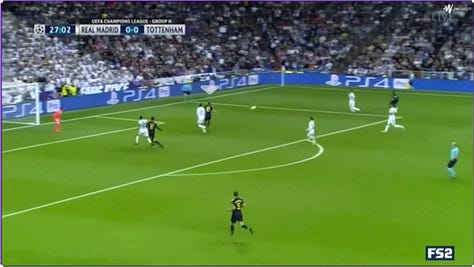
Pictures taken (4)
2018/2019: The Transition from Finisher to a Roamer Number 9-10:
Statistically, the 2018/2019 season was comparatively weaker for Harry Kane, as he scored 17 Premier League goals—a noticeable drop from his previous prolific campaigns. The season started well, but injuries took their toll, causing him to miss 18 matches overall, including 10 Premier League games—the highest number of absences in his Tottenham career. However, despite this dip in personal numbers, this season may be remembered as one of Tottenham’s most successful European campaigns, as they reached the Champions League final—though their overall performance was less than stellar.
With Mousa Dembele’s departure to China and no new signings made throughout the season—making Tottenham the first English club ever to go an entire season without transfers— as injuries to Eric Dier and Victor Wanyama left Moussa Sissoko and Harry Winks as their only senior central midfielders for a large part of the campaign. Whilst Spurs may have become weaker than previous seasons, fortunately their Manager has become better.
Fortunately, Mauricio Pochettino adapted by introducing a more versatile system to cover the midfield gaps. One of its key elements was dropping Kane deeper into midfield to act as a “playmaker”. Harry Kane demonstrate his passing range and ability to create as well as score. With the likes of Son, Lucas and Dele always looking to stretch the opposition backline as Kane’s strike partner, this has enabled Kane the freedom to drop off his marker and into midfield positions to create.
Kane drops off dragging Rudiger with him high up the pitch, before releasing Son with a first time round the corner pass in behind David Luiz.(5)
Once again Kane collects the ball in the middle third, dragging a centre back towards him before curling the ball in behind for Dele.(same source as above)

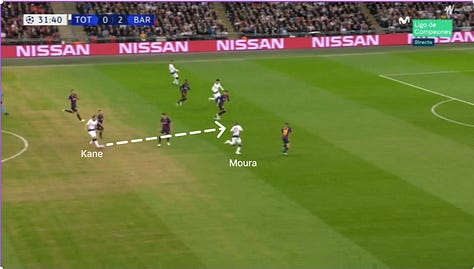

Kane receives the ball in the middle third of the pitch, moves intelligently into open space, and showcases his excellent ball-carrying ability before delivering a brilliant pass to Lucas Moura, who cleverly exploits the space. The chance nearly resulted in a goal, if not for Ter Stegen’s superb save.
The England striker is of course one of the world’s finest goalscorers, but he also has a wonderful range of passing which Spurs have benefited from this season. It has been particularly beneficial in transition moments, as he drops off to receive whilst dragging his center back marker out of position. His ability to then find his partner running into depth with first time round the corner passes and curled, lofted through balls is up there with the best.
2019/2020: Pochettino left, White Hart Lane vanished. Mourinho arrived, but White Hart Kane stayed.
With Pochettino’s departure , José Mourinho came —and along with him, a new chapter for Harry Kane. The transformation of the club’s style and identity also brought a clear shift in Kane’s role. His goal-scoring numbers noticeably declined, but this was balanced by a broader, more creative contribution to Tottenham’s attack. Over the following four seasons, Kane scored 30 fewer goals but provided 15 more assists, facilitating the rise of teammates like Son Heung-min alongside him in Spurs’ frontline.
Pochettino’s remarkable era, marked by impressive performances but disappointing in terms of trophies, came to an end. In his place arrived the “special one,” José Mourinho—the man whose teams rarely fail to claim silverware wherever he goes.With Dele Alli’s decline and Christian Eriksen’s transfer to Inter Milan, the creative burden increasingly fell on Kane, who had long been a gifted playmaker—a facet of his game that became even more evident in the previous season.
One of the many interesting things about Kane’s evolution is that he has always been an outstanding playmaker. Go back to his first season as a Spurs regular — 2014-15 — and there are flashes of genius in this regard. A sensational pass that cuts out almost the entire Manchester United defence to create a one-on-one for Ryan Mason in a goalless draw in December 2014 is one of many good examples.
Tottenham’s attacking strategy began to revolve around Kane and Son. It mirrored Mourinho’s approach at Real Madrid, where Kane took on the role of Benzema while Son played like Ronaldo. Kane would drop into midfield, drawing the opposition’s central defender, then break the defense line with a precise pass. Meanwhile, Son exploited the space that Kane created with intelligent runs.
Relying on Kane’s excellent passing ability, combined with his sharp game-reading and spatial awareness, alongside Son’s remarkable finishing skills, Mourinho’s tactical recipe was perfectly set for the upcoming season—and what a season it was.
A small observation: watch the body movement and line of sight of the Leicester players toward Lucas Moura. Here, Harry Kane’s cleverness and skill are evident as he delivers a perfectly weighted long pass to Son’s feet, by passing the entire Leicester defense.
The image shows the idea Mourinho aimed to implement: Harry Kane dropping deep as a passer, playing with his back to goal, while Son and Lucas stretch the play wide. As Kane turns, they make diagonal runs into the central spaces to receive his pass. This idea would become fully refined in the following season.
The numbers are pretty stark — the model went from confidently classifying Kane as a box-focused Finisher for several seasons to describing him as a mobile Roamer for the last two.
In 2017-18, Kane had a 91 per cent probability of being characterised as a Finisher — defined as a player focused on getting in the box and finding shots — followed by 62 per cent and 82 per cent in the subsequent two seasons. In the two most recent campaigns, that percentage became negligible.(6)
Image taken from The Athletic (same source as above)
Tottenham’s opening goal against Leicester perfectly summed up the idea Mourinho was trying to implement. Harry Kane received the ball with his back facing the opponent's goal., while Son was already preparing to make his run. As Kane shrugged off the pressure, Son exploded into the open space, using his pace to full effect. Kane then delivered a silky outside-of-the-foot pass—a perfect example of his passing variety, more like a classic number 10 than a traditional striker—setting up Son, who finished the move with a goal for Spurs.
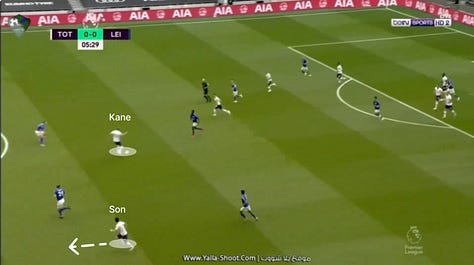

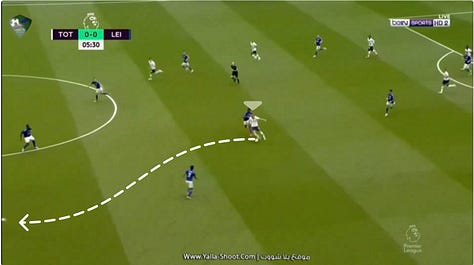
2020/2021: The Son–Kane Partnership
Many consider this to be Harry Kane’s best individual season. He finished the 2020/2021 Premier League campaign with 23 goals, claiming the Golden Boot, and 14 assists, making him the league’s top playmaker—outperforming elite midfielders like Bruno Fernandes and Kevin De Bruyne, two of the finest creators in modern football.
Kane’s incredible partnership with Heung-Min Son was a standout feature of the season. The duo combined for 14 goals, setting a new Premier League record for the most goal combinations between two players in a single season.
This was the vision Mourinho had been building from his very first months at Spurs. In the Southampton match, Kane provided four assists—all to Son—in a performance that highlighted his transformation into a complete forward and a maestro in the No. 10 role, creating goals in a variety of ways.
Images taken from The Athletic (same source as above)
Mourinho continued what Pochettino had started with Harry Kane as a solution for progressing the ball in build up —something we mentioned earlier. However, this time, the concept had evolved significantly, as clearly showed in these images.

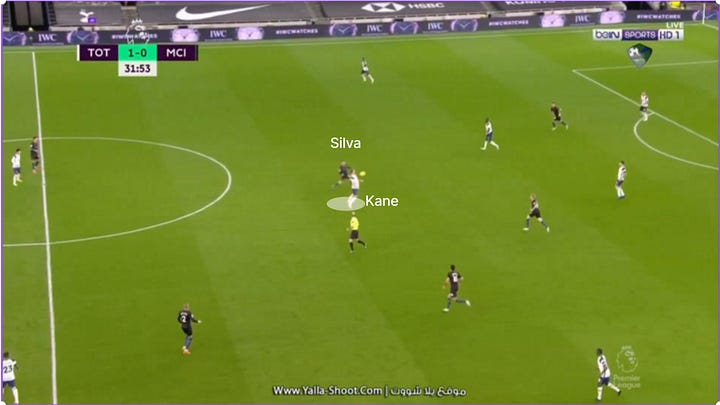
As usual, Manchester City applied zonal pressure, cutting off the passing lanes to Højbjerg and Reguilón. In response, Harry Kane dropped deep into midfield, exploiting Ndombele’s movement that had drawn Rodri out of position. At that moment, Dier attempted a long ball to Kane. But Guardiola had anticipated this pattern and placed his favorite chess piece—Bernardo Silva—in position to block the transition.



This time, Gabriel Jesus positions himself poorly, allowing Dier to find Højbjerg with a pass. Højbjerg then plays it to Alderweireld, who quickly shifts it to Aurier, successfully passing City’s first pressing line. Meanwhile, Harry Kane makes a clever move behind Bernardo Silva, dragging Rodri with him—freeing up Ndombele as the unmarked man.
Had it not been for Bernardo’s exceptional pressing ability—and Aurier’s lack of composure—Tottenham might have broken through City’s press entirely.
The Englishman’s brilliance didn’t stop in this match, as he contributed to both of his team’s goals. The first goal was a perfect example of the false nine role: when the ball reached Ndombele, Kane dropped deep to receive it. What stood out was Kane’s exceptional intelligence and spatial awareness — noticing Son’s run, he deliberately dragged both Laporte and Dias into midfield. The ball then reached Son, who scored Tottenham’s opening goal.
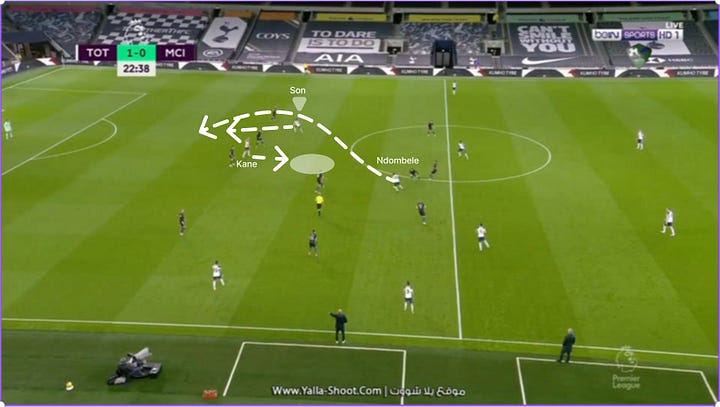

In the second goal, Harry Kane’s role as a playmaker came to the fore. He dropped into midfield to lead the transition—receiving the ball, turning, carrying it forward, then delivering a pass to Lo Celso, who slotted it into the net. Kane’s role at Tottenham over the past four seasons perfectly embodied these hybrid duties, all while maintaining his clinical finishing ability, which never faded.



The match against Crystal Palace was a perfect projection of Harry Kane’s season—a historic performance in which he scored twice and provided two assists. Every moment in that game was worth highlighting, but if I were to break them all down, I’d never finish writing the article.

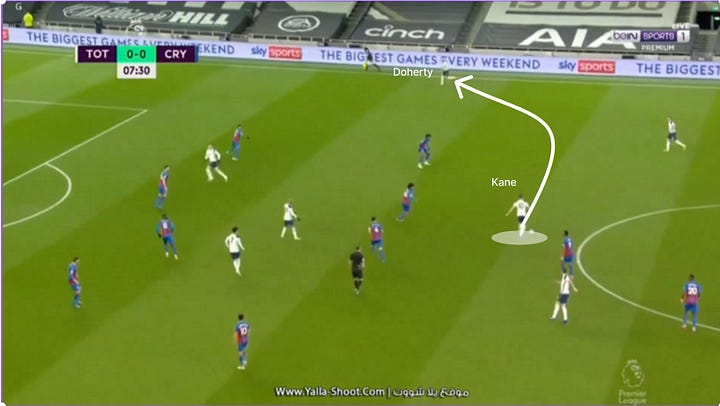
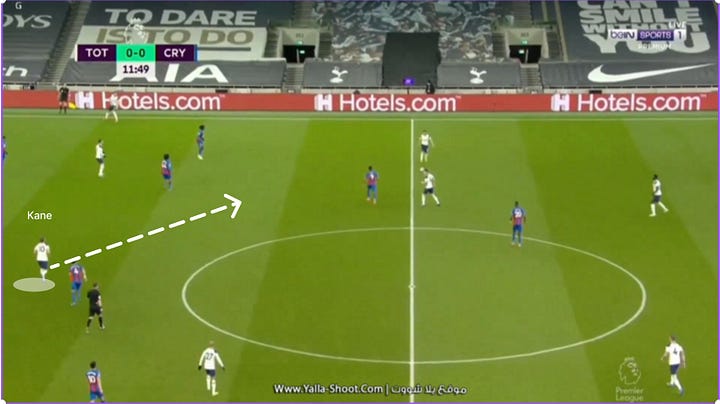

Harry Kane has always been a reliable solution in midfield, with exceptional ability to switch the play.
Harry Kane positions himself in midfield on the same line as Winks.
Harry Kane is considered a complete striker due to his ability to both start and finish attacks, as demonstrated in the following images. He contributes to build-up play before making his run into the penalty area to score. Perhaps his incredible goal against Crystal Palace is the best example of this.
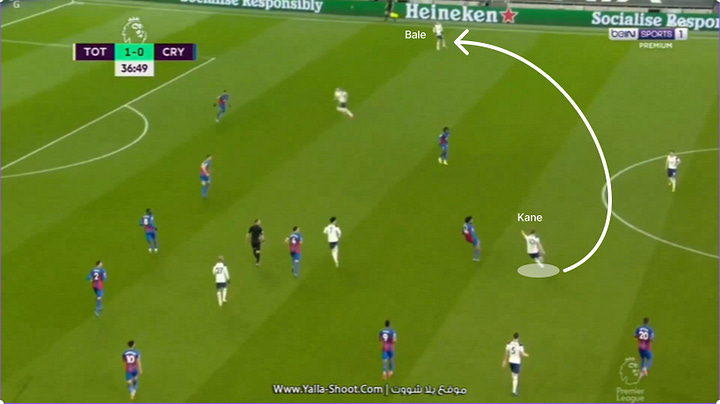

His incredible goal against Crystal Palace showcases his genius and versatility — the smart movement, calling for the ball, leading the attack, the curved run into midfield, and the spectacular finish — a true masterpiece, as always from the prince.
His partnership with the Korean Son Heung-min is considered the best scoring duo in Premier League history, as Kane and Son have scored more goals together than any other pair since Son joined Tottenham in the 2015-2016 season. Each has contributed 47 assists, with 24 from Son and 23 from Kane. Interestingly, Kane contributed 20% of Son’s total goals, while Son accounted for 11% of Kane’s total goals.
By the end of the 2020/2021 season, the duo had scored 136 goals together when playing side by side, averaging 1.33 goals per 90 minutes, outperforming other great duos like Salah and Mane, Aguero and Sterling, Henry and Perez, making them the highest-scoring partnership in Premier League history. Additionally, the pair scored over 200 goals in the last four seasons, representing about 49% of Tottenham’s total goals during that period.
“Up front, [they have] speed like crazy – Harry Kane, what a player, and obviously fits in that idea extremely well(transitions).There’s a blind understanding between them (Son-Kane) , so I’d say it’s probably the biggest challenge for protection we face for a long time.”jurgen kloop
The West Ham match showcased the brilliance of their attacking partnership, with Son scoring one goal and assisting Kane, while Kane scored two goals (one assisted by Son) and provided an assist to Son.
Notice where Harry Kane received the ball, even though he is the team's striker — but what's even more impressive is seen in the next image.
Harry Kane assist the goal from about 60 meters away with a pass as precise as those from Messi and De Bruyne. Let’s not forget the brilliant finish by Son, who helped complete this masterpiece.
This goal shows Harry Kane’s great finishing, precise dribbling, and exceptional shooting accuracy that sets him apart from other strikers worldwide.
Let’s put aside the number of goals and assists, because it’s not just about that at all. The key point is that Harry Kane Carries the team’s burden—he plays not only as a striker but also as a winger, playmaker, and sometimes a deep-lying midfielder. Kane has created 14 big chances to score, matching the number by Jack Grealish, who is considered Aston Villa’s lifeline (7). By the way, no other striker in Europe has created that many chances. Romelu Lukaku, who is having the best season of his career, created only 10; Benzema also created 10; and Lewandowski, widely regarded as Europe’s best striker, created 8… (8)
All the top strikers in the Premier League—like Calvert-Lewin, Bamford, and Jamie Vardy—each missed at least 18 clear-cut chances, while Harry Kane missed only 13. He also recorded the highest positive difference between expected goals (xG) and actual goals among all Premier League forwards, making him the most clinical striker in the league. In comparison, Lukaku missed 19 big chances, Haaland the same, Cristiano Ronaldo missed 27, and Lewandowski 25.
It’s enough to say that all of those players primarily operate inside the box, while Harry Kane literally covers every inch of the pitch. Just look at his heat map for the season—you’ll be stunned by how much ground he covers. Sometimes he’s deep in midfield, other times around the center circle, occasionally hugging the touchline, and of course, often in his natural position inside the penalty area.
Honestly, I’m sorry Ruben Dias, Bernardo Silva, Gundogan, and even De Bruyne… I’m sorry Son, and I’m sorry Bruno, for the incredible seasons you all had. But Harry Kane was the best player in the Premier League this season—not just statistically, but in terms of overall influence. Perhaps Tottenham’s sixth-place finish and the chaos at the club, including Mourinho’s sacking and the the naming of Ryan Mason as interim coach, kept him off the final shortlist. But make no mistake—Kane was the best player in the league that season.
2021/2022: The Leader Who Served His People
The summer of 2021 was a turbulent one for Harry Kane. After the heartbreak of losing the Euro final to Italy, he publicly expressed his desire to leave Tottenham, frustrated by the club’s lack of a genuine project. He had long sacrificed personal glory for the sake of the team, but the trophies never came. Managers came and went, yet the trophy cabinet remained bare.
Meanwhile, in the northwest of England, a cunning fox was watching closely—Pep Guardiola, who had long admired Kane, urged City’s director Txiki Begiristain to bring the Prince of London to Manchester, hoping the cold northern skies would cool the flames of his burning summer.
Rumors swirled. “Harry Kane to City” dominated the headlines. The league’s best striker joining to the best team... City made their offer, but Daniel Levy refused to sell him to a direct rival. Perhaps Levy realized that giving a competitor a weapon like Kane would harm him more than City’s money would benefit him, and he chose not to dig his own grave(9). He convinced Kane by bringing in Nuno Santo as the savior for the season — But lies fade quickly . Nuno was sacked less than four months after taking charge, even before he truly got to know Harry Kane. He was replaced the very next day by Antonio Conte.
it seemed as if Tottenham were no longer capable of repaying Kane’s loyalty. The increasing pace of the modern game—and the tactical reliance of successive managers, from Mourinho to Nuno Santo and finally Antonio Conte, on Kane to lead transitions—was not only robbing him of collective trophies, but now even threatening his usual claim to the Golden Boot, which went to his Korean teammate that season.
Perhaps the worst period of Harry Kane’s career came at the start of the 2021/22 season. After losing the Euro final and missing out on a dream move to arguably the best team in Europe, he appeared on the pitch like a body without a soul—mentally broken. His emotional collapse was evident, and as he fell, so did Tottenham. His importance to the team was painfully clear.
But as great players do, Kane turned adversity into fuel. Everything changed from the first-leg match against Liverpool, where he returned to his fierce, complete version—combining lethal finishing with creative playmaking. He even made history by becoming the first player ever to score a hat-trick in all major European competitions, when he netted three goals in just 20 minutes against Slovenian side Mura in the UEFA Europa Conference League .
"Everybody knows [on Kane's qualities]. Just take a look at him and his good he is. Exceptional striker.Top attributes, right, left, dropping, quality to play assists, score goals in the box, score goals arriving, so an exceptional striker.” Pep Guardiola
Guardiola continued"Harry Kane remains one of the best strikers I have ever seen in my life, What an exceptional player - the numbers and, more than the goals, the quality. That they didn't win a title (doesn't mean) he is not a good player. I think he proved that. Are coaches considered worst if they don’t win trophies?"
On February 19, 2022, in the headline clash of Matchweek 26 between Manchester City and Tottenham, Harry Kane delivered a tactical and technical masterpiece unlike anything I’ve seen before. In all my years of watching Premier League football, I have never witnessed a striker put on such a complete and dominant performance against Pep Guardiola’s City at the Etihad.
City were outstanding in every phase of the game—structured pressing, smart positioning, and constant overloads in space. They controlled the tempo and flow. But Tottenham had a secret weapon: Harry Kane.
Manchester City's pressing took the usual zonal defense shape of 3-3-3-1, with the first pressing line moving in perfect coordination, relying heavily on Bernardo Silva’s skill in curved pressing, while Foden, De Bruyne, and Sterling maintained a steady and synchronized pressing rhythm. Tottenham, on the other hand, mainly relied on Romero to send long balls. Guardiola’s idea was smart and successful for most of the match, and if it weren’t for Harry Kane’s brilliance, that plan would have been 100% successful.
When the ball reaches Davies, you’ll see the City quartet positioned just like in the first image, but this time on Davies’s side — showcasing the brilliance of City’s pressing. Sessegnon and Kulusevski will be drawn outward, while Son acts as bait for Rodri, and Dias moves forward to preemptively defend against Son. Here comes the key moment: Harry Kane drops deep — right in front of Rodri — pulling Laporte along with him.
When the ball reaches Kane, Rodri and Dias notice it— but too late. The Englishman had the entire play mapped out in his mind, and with a silky-smooth pass, he placed Son into the blind spot—behind Dias’s back—right in front of the City goal. Son then laid the ball off to Kulusevski, who surged past Cancelo, exploiting the left vacant space behind Laporte. The result: Tottenham’s opening goal, scored by Kulusevski, assisted by Son, but the mastermind behind it all was Harry Kane.
His second goal was a perfect example of what he offers in the later stages of his seasons: dropping deep to receive the ball in midfield, escaping the pressure, then switching the play. After that, he makes a direct run into the penalty area, attacking the space by exploiting Cancelo’s and Laporte’s poor coverage, and with a single touch, finishes the ball into Ederson’s net following a brilliant pass from Son.


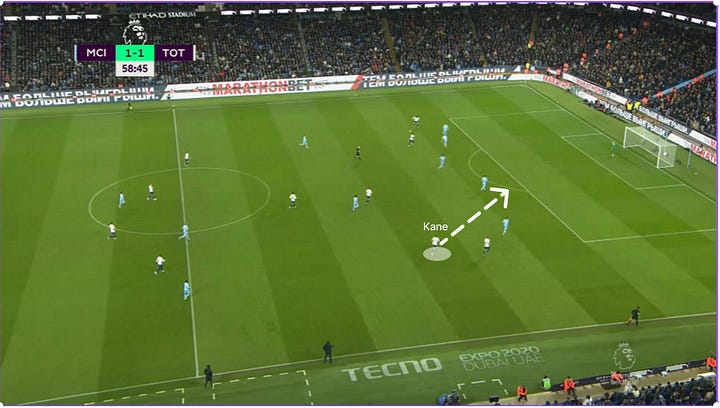
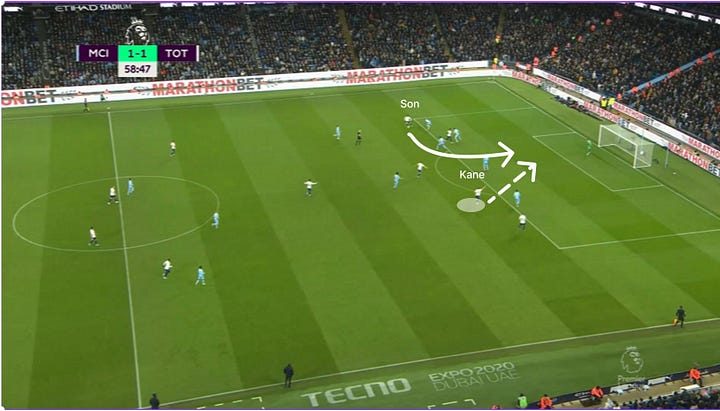
England’s captain did not settle for scoring just two goals; he was the beating heart of his team’s plan, consistently dropping deep to make himself available for the first pass and skillfully finding teammates ready to sprint forward alongside him.

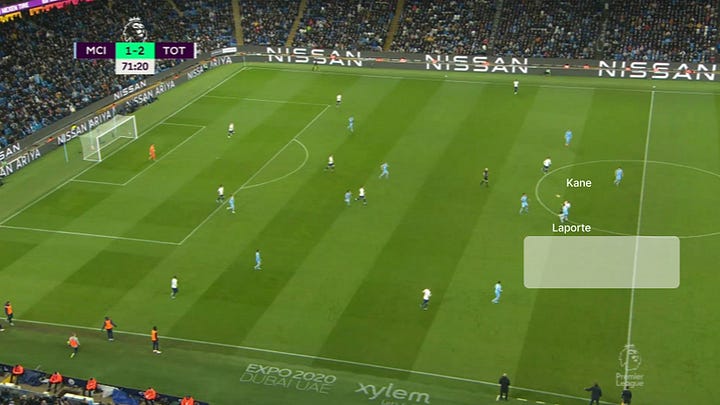
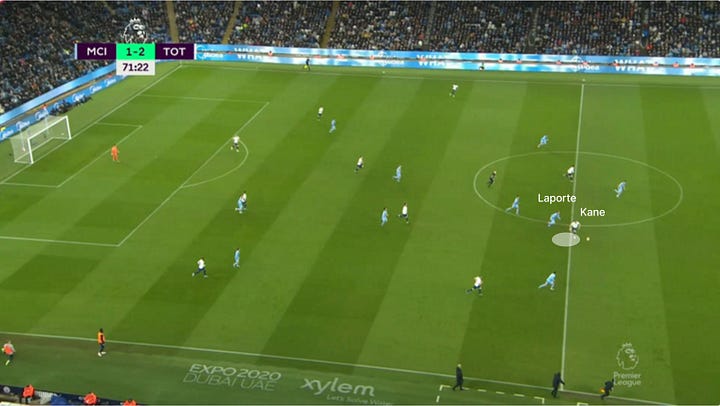
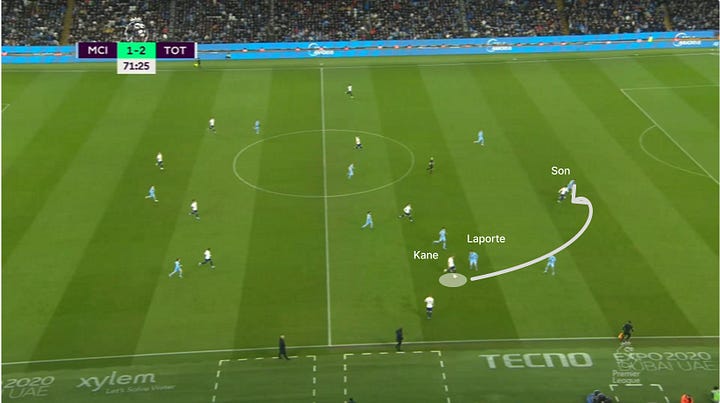
Harry Kane proved why Guardiola insisted on him during the summer. The Englishman delivered a landmark performance against what I consider the strongest tactical version of City. Perhaps Guardiola was right when he once said that Tottenham was “Harry team.” The Spanish coach remarked after the match, "There is no need to show the goals he scored tonight to prove his quality; the whole of the UK knows his quality."
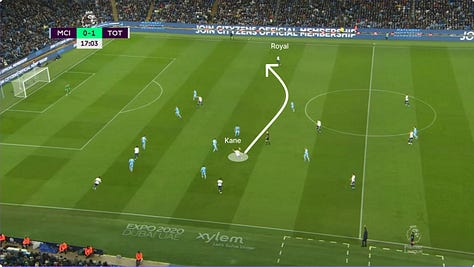

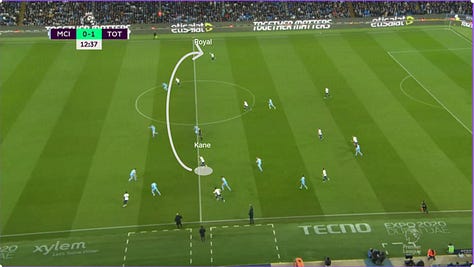


Harry Kane recorded the worst expected goals (xG) rates of his career during the 2018/2019 and 2019/2020 seasons, according to Understat, along with last season and the current one, which makes sense as these are his least prolific scoring seasons (only 17 goals). But, as with every coin, there are two sides...
In three of his last four Premier League seasons (2021/2022, 2020/2021, and 2018/2019), Kane posted his best expected assists rates, with the 2016/2017 season ranking fourth. That season also saw his highest rate of chance creation per 90 minutes. It seems those seasons were not only his worst in scoring but also his best in playmaking.
Additionally, during those three seasons, Kane’s ball touches in the middle third of the pitch per 90 minutes were the highest, led by 2020/2021, followed by 2021/2022, then 2018/2019. Regarding the defensive third, 2018/2019 ranked fourth, followed by 2019/2020 in third place, according to FBref data.
Moreover, those seasons were his highest in terms of chance creation from open play, shot-creating actions, passes into the final third and penalty area, forward passes, and progressive carries into the final third and penalty area, with greater distances covered than in previous seasons. All these rates are calculated per 90 minutes according to FBref.
So, what’s the other side of the coin?
Simply put—as you’ve probably guessed—it’s all about the roles.
Harry Kane is no longer just the striker who finishes chances. He’s now the one who creates them too. Season after season, he’s dropped deeper and deeper, drifting away from the box. Just look at his heat maps over the years: the man is running across every blade of grass. He balances the flanks to help neutralize numerical disadvantages his teammates face, drops into midfield to initiate transitions, and orchestrates attacks from deep.
This shift has been most evident in the last two seasons—more than at any other point in his career. Kane touches the ball in virtually every area of the pitch. His touches per game have skyrocketed. In fact, over the last two seasons, Kane averaged 4.15 touches in the defensive third per 90 minutes—compared to just 1.87 in 2017/2018. That’s more than double. Per match.(10)
His deeper role also paved the way for others to shine. Son Heung-min, for example, won the Golden Boot with 23 goals. Dejan Kulusevski emerged as a serious threat, and even Emerson Royal started to look more effective on the right. Kane was no longer just the scorer or the playmaker—he had become the entire system.And to top it off, according to Statmuse, Kane created 19 big chances—more than Kevin De Bruyne, Bruno Fernandes, and even Mohamed Salah(11). For context, even Ballon d'Or winner Karim Benzema, in the best season of his career, created just 14.(12)
World Cup 2022: Everything Revolves Around Harry Kane — How His Role Changed Even for England
As always, England entered the World Cup as one of the top contenders. With a star-studded squad, the Three Lions were naturally seen as a force to be reckoned with. At first glance, Harry Kane’s numbers looked underwhelming—just two goals throughout the tournament, none in the group stage.
But as with everything in Kane’s career, his impact is like an iceberg: the surface tells only a fraction of the story. To truly understand his role, you have to look beneath into the depth of his movement, vision, and influence.
In the World Cup qualifier, Kane scored a hat-trick and provided an assist, showcasing his exceptional finishing ability in every form — with his head, his weaker foot, and even a bicycle kick. Each goal was a testament to his technical quality and versatility as a striker.
The opening match against Iran highlighted a major tactical shift in Harry Kane’s role. England’s top scorer had now become the team’s primary playmaker — it felt like watching Tottenham’s Harry Kane, only surrounded by a higher-quality squad.
Gareth Southgate fully utilized his striker’s ability to find wingers making runs behind the defense, building the entire attacking setup around Kane. The result: Kane contributed directly to two goals in the opener, not by scoring, but by creating — further proof of his evolution into a complete forward.



The third goal was a perfect showcase of Kane’s inexhaustible qualities outside the box. He received the ball from Pickford — once again demonstrating his superb use of body positioning — then quickly laid it off to Bellingham before immediately making a run into the empty space.After receiving a brilliant return pass from Bellingham, Kane shielded the ball expertly to create just enough space for a pass, then delivered a perfect assist to Sterling, who calmly finished it into the net.



The fifth goal mirrored the third almost exactly — Kane brilliantly received the ball from Pickford, attacked the open space, and delivered a well-timed pass to Rashford, who finished it in style.



Senegal’s goal was a brilliant example of England’s tactical versatility — a beautifully executed move that reflected one of the key principles of positional play: Positional superiority .In the first frame, Kane drops deep to receive a pass from Foden. Koulibaly immediately follows him, leaving a space behind. Bellingham notices this and hit the space behind Koulibaly — as shown in the second frame. Koulibaly tries to recover quickly, but Bellingham had already made the move.Now free in space, Kane delivers a perfectly timed pass to Bellingham, who then squares it to Henderson arriving from deep — completing a stunning team goal.
Harry Kane performed the false nine role to perfection. He neither scored nor assisted directly, yet his movement and intelligence were vital in making the goal happen.
The Englishman didn’t stop there; his pivotal role in linking and organizing play was clearly demonstrated in the matches against Senegal and France.





His prominent role in organizing play and moving the ball.



A permanent solution for linking play on both sides.


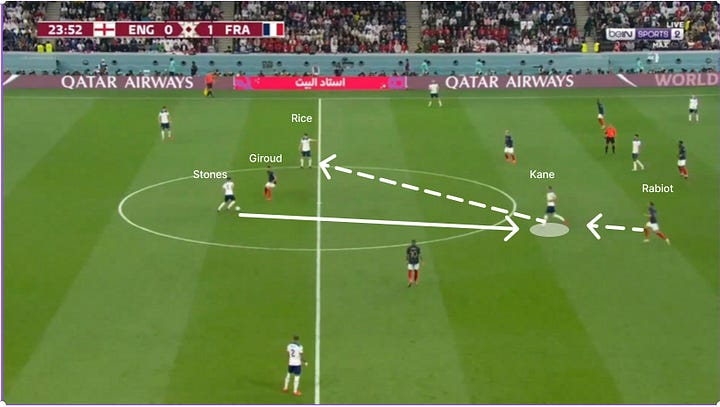

Harry Kane was an immediate solution whenever England struggled to build up play.
Harry Kane’s role with England changed significantly. He was the best striker at the World Cup alongside Giroud. The stats from FBref clearly show the difference between his 2018 and 2022 performances: his expected goals (xG) rates dropped in 2022 compared to 2018, while his assists and expected assists (xA) increased dramatically. Even his ball-carrying stats rose sharply.
The second image highlights his playmaking role, showing that despite his 2018 prowess in long passes and progressive passing, the 2022 numbers reveal his uniqueness among world strikers in creating chances. Kane mostly operated in his own team’s third and penalty areas—as shown in the third image—which aligns with his deeper role in helping build attacks and frequently dropping back in defense during set-pieces. As usual, he spent relatively less time in the opponent’s defensive third compared to other strikers.
Harry Kane is an incredibly remarkable and top-class professional. He is the second highest scorer in England’s World Cup history with 8 goals, just behind Gary Lineker who scored 10. In his first participation, Kane scored 6 goals, and it seems he can easily surpass Lineker’s record in the Qatar 2022 tournament, especially with outstanding teammates like Saka, Bellingham, and Foden by his side.
Despite his brilliance, Harry Kane remains humble and far from arrogance, always being a shadow man and a true leader in every sense. This is evident from England’s coach Southgate’s statement “Harry is our leader, both on and off the pitch. From my opinion, he is the best striker in the world. He is more than just a goal scorer — he makes an impression through his work rate, vision, and mentality. He is an exceptional professional, and we are lucky to have a captain like Harry.”
"Harry Kane is the best striker in the world. We are lucky to have him. He excels at scoring goals, dropping deep, passing, and creativity. He is a complete player, an ideal leader. He never stops working and always shines in crucial moments. He is an amazing player and a great captain."This was Declan Rice’s tribute to Harry Kane.
Harry Kane is one of the elite playmakers in football, standing out uniquely among all strikers worldwide. He is an exceptional creator; everyone who has played alongside him has elevated their performance — from Son, Dier, and Lucas Moura to Saka, Rashford, and Bellingham in the national team. This is precisely the role of a playmaker — enhancing the performance of those teammates. Honestly, he is no less than the historic great playmakers, and both observation and statistics clearly prove this.
2022/2023: "Harry Team"
Because legends depart, leaving behind a lasting legacy Harry Kane’s final season was truly legendary in every sense. This year, things were different at Tottenham; unrest began somewhat early, and a cloud of indifference settled over the shiny new stadium. Yet one thing remained constant: Harry Kane kept scoring.Three managers changed in a single season, but Kane was like an arrow catcher—always alert, always lurking close to the goal without fail, stealing the spirit from opposing defenses.
When Kyle Walker left and Danny Rose’s performance declined, Tottenham lost momentum at the full-back position, and the team was never the same again. Mousa Dembélé’s body betrayed him, Christian Eriksen was sold, and Dele Alli fought battles unknown to us all. Each time their strengths faded, Kane changed somehow—in a way that kept the team alive. He played deeper. Sometimes slower, sometimes faster. He could become fiercer when needed. When the team’s pride finally vanished, overwhelmed by the frustrations of Mourinho and Antonio Conte and the chaos before, during, and after their tenures, Kane’s importance on the pitch never wavered. Tottenham’s defenders forgot how to defend. No midfielder could intercept or pass effectively. The entire team was exhausted—even Son and Kulusevski offered little—yet Kane continued to score and kept creating chances for others.
He scored 30 goals this season for a Spurs side that finished outside the European places in eighth. It was their worst league finish since 2008-09.There really is no overstating just how impressive Kane’s goalscoring has been this season. His 30 goals would have been enough to win the golden boot – either outright or as joint-winner – in 24 previous Premier League seasons. But for the superhuman Erling Haaland, he would have won it this year, and he was 10 clear of the next highest scorer (Ivan Toney, on 20).
His 30 goals came from just 21.5 expected goals. The 9.5 goals he outperformed his xG by made up the vast majority of Tottenham’s overperformance in front of goal this season. Spurs scored 70 goals from 57.8 xG in 2022-23, with their difference of 12.2 the third highest in the Premier League behind Manchester City and Arsenal. Kane’s elite finishing ability – he has ‘beaten’ his xG in all but one of his Premier League seasons since becoming a Spurs regular – has this season very nearly been the only reason Tottenham have outperformed their underlying numbers.
Without him, clearly, they’d be far, far worse off, and he is essentially responsible for ensuring their dreadful defensive record – which was the sixth worst in the league – has not had an even more catastrophic impact on their campaign.
Image taken from Understat
Spurs finishing eighth represents the Premier League’s lowest ever league finish by a team with a player who has scored more than 25 goals. Shearer scored 31 goals for Blackburn in 1995-96 and Kevin Phillips hit 30 goals for Sunderland in 1999-2000, both in teams that came seventh, but Kane went one better – well, worse – this season. His consistency is highlighted in the fact he scored in 26 different games this season. His brace on the final day of the season at Leeds on meant Kane equalled the previous Premier League record, held by Andy Cole, of 26, though he achieved that in 1993-94, which was a 42-game season. Kane’s 26 in 2022-23 is therefore the outright record for a 38-game season.(15)
The England international got the job done for Spurs in a number of different ways this season. He has developed a wide range of finishes which make him an extremely complex matchup for any defence. In addition to this, the quality of his movement – which has significantly evolved over the last few seasons – makes him a threat even before he has touched the ball, an extra issue for the opposition to worry about. Over the course of the season, his movement in transition and at setpieces especially stuck out as one of the main reasons why he is so effective in front of goal.
image taken by Opta
Kane’s first goal came away at Chelsea, a raucous Stamford Bridge providing the backdrop for what was a feisty, intense and extremely entertaining 90 minutes and beyond. Chelsea largely dominated the game but Spurs found themselves just one goal down going into the sixth minute of added time, and they had just won a corner kick. Harry Kane’s positioning during these situations this season has particularly interested me.
He is usually lurking around the backpost area, waiting to pounce on flick-ons or long, arching deliveries.At this moment, however, Kane went the traditional route. Finding a seam in Chelsea’s zonal marking setup, he rose up and deftly flicked a header past Edouard Mendy and into the goal. The first of many points that the Englishman’s goals would rescue out of nothing for the North London side.
Against Wolves in the very next fixture, he showed that knack for sharp movements at the backpost. Initially wresting for position with Nathan Collins, Kane took a heavy step away from goal, sending Collins in the wrong direction and then bursting towards a near post-flick-on and nodding it home.
In a 2-1 home loss to Newcastle, Kane was lethal in that same area. This time, simply overpowering Kieran Trippier to get his head onto a flick-on and the result was the same. It is an interesting quirk in his game that the Englishman has been able to find and consistently exploit an opposition weakness in this way. It is therefore unsurprising that he has reached the top of the Premier League’s all-time headed goals chart with 40.
Zooming out to the larger collection of finishes, it is not an easy task to pick a “best” goal by whatever metric. With that in mind, I will completely sidestep the challenge and instead highlight a few of my personal favourites. Third on this list is his slightly awkward but impressive finish away at Brighton. Son flashes a cross into the box at about waist height and Kane, not very far out from the cross, contorts himself into position to redirect the ball past Robert Sanchez in a remarkable display of awareness and body control.
Next is his finish against Brentford, a stunning mix of power and finesse. Off a free kick from about 30 yards out, Kane run onto a Kulusevski layoff and found the top corner with a truly amazing strike.
Kane’s goal at home against Crystal Palace takes the top spot in these completely arbitrary rankings. It represents a number of the skills the forward excels at, packaged together to provide a result we have become all but used to by now.Receiving a bouncing ball from the Spurs’ left with runners beyond him, Kane controlled, swivelled and then found Pedro Porro in acres of space on the opposite flank. He then charged into the box, to his favoured haunt at the back post and put his header into the ground and past Vicente Guaita to become the second all-time Premier League scorer.
Essentially, Kane has just become far more efficient in front of goal while adding creativity to his game. The number of times that Kane’s only involvement in a Tottenham sequence is him taking the shot has, for the most part, trended downwards. That fits with what we’ve seen on the pitch: Kane dropping deeper to get involved in build-up more often.
The number of shot-ending sequences in which his only involvement is in the build-up (not taking the shot or laying on the chance) is down at its second-lowest rate in any season in his Premier League career. That is probably down a stylistic change in Tottenham’s game, as they became less possession-focused under José Mourinho and Antonio Conte.Meanwhile, his involvement as the chance creator in shot-ending sequences was at its highest rate in 2022-23 of all of his seasons as a regular starter for Spurs (1.34 per 90). Add in the sequences in which Kane’s involvement is in the build-up and creating the chance, and his 2022-23 rate is also the highest in his career.
In short, Kane is involved in fewer shot-ending sequences for Spurs than he used to be, is shooting less and creating more, but he is also more effective than ever in front of goal. As he gets older, he is getting more and more efficient, somehow managing to improve his incredible finishing.(16)
image taken by Opta
Detractors claim Harry Kane’s season – his goals, have lacked any significance in the greater team context. That seems unfair to the forward (and as a way to discredit his season, it actually is) since he has obviously done his job and done it exceptionally well .The prince bore his throne alone. Even his trusted Korean companion couldn’t offer the support this time — a dip expected, perhaps, after his scoring explosion the previous season and the constant managerial upheaval. Maybe Guardiola was right, or maybe his words simply captured the reality of Tottenham this season: it wasn’t just Spurs… it was Harry’s team — quite literally, Harry Team.
His journey with Tottenham was fascinating — so fascinating that one would watch Spurs just for him. He didn’t win this or that or the other, but he was the main reason they ever came close to winning this, that, and the other. As Jurgen Klopp once said about facing Tottenham: "It’s going to be a tough match — they have attacking solutions, and they have Harry Kane." Yes, in the end, they had Harry Kane...
Some statistics worth highlighting:
Every season, Harry Kane enters the Golden Boot race while being — quite literally — one of the least-served strikers among top forwards, especially compared to his peers in the traditional "Top 6". Take Luis Suárez, for example: his average expected goals (xG) per game at Barcelona was 0.78. Karim Benzema from 2014/15 onward posted 0.69 per game, Sergio Agüero at Manchester City had 0.82, Edinson Cavani at PSG also 0.82, and Robert Lewandowski at Bayern Munich an astounding 1.01.
Harry Kane? Considerably lower — just 0.62 xG per game during his spell with Tottenham from 2014/15 onwards. And if not for the presence of Christian Eriksen and Dele Alli in their prime, even that figure would have dropped by another 0.10–0.15.
Despite this, Kane has overperformed his expected goals tally by 25 goals in the Premier League since 2014 — a margin unmatched by any of the aforementioned names.
According to FBref, Kane ranks only in the 79th percentile for non-penalty expected goals (npxG) among strikers in the Premier League — a relatively low mark when compared to the 99th percentile figures of Haaland and Lewandowski.
The relatively low figure can be attributed to two key factors: the first being the team’s structure and tactical setup, and the second relating directly to Kane himself — who often operates in roles far from the penalty area, functioning more as a playmaker than a traditional striker. As shown in Image 2, Kane’s touches inside the opposition penalty area (touches Att Pen) ranked in just the 45th percentile among Premier League strikers — a surprisingly low number for a forward of his caliber.
Likewise, his progressive passes received percentage was only 43%, indicating either a low volume of such passes or that he receives them in deeper, less threatening zones, far from the opponent’s box.
One of the final visuals highlights Kane’s exceptional efficiency in converting key passes into goals. However, his low tally of assists stems largely from his teammates’ poor finishing — a long-standing issue during his time at Spurs (as further discussed in Image 4). Kane was expected to register 7 assists, but only recorded 3, making him statistically the least efficient creator among top Premier League forwards like Haaland (8), Ivan Toney (4), and Ollie Watkins (6) — despite Kane's clear superiority in underlying creative metrics.
In Image 3, it becomes clear that Harry Kane’s touches are spread across nearly every zone on the pitch — with percentages comparing his positioning to other strikers. Ironically, the area where he touches the ball the least — aside from his own penalty box — is the opposition’s penalty area, which is supposed to be a striker’s primary zone of influence.
Yet, despite this, Kane still managed to score an impressive 30 goals, all while performing a wide array of responsibilities beyond scoring — often dropping deep and contributing to the build-up. He finished as the second-highest scorer in the league, behind only Erling Haaland, who, unlike Kane, rarely operates outside the penalty area or takes on such multi-faceted roles.
All images are taken from FBref (17).
He holds another unbelievable record: Harry Kane leads the Premier League in goals scored with his weaker foot (41 goals) and is tied with Peter Crouch for the most headed goals (40). In Image (4), Kane’s finishing ability is highlighted through xG statistics. Since the introduction of expected goals (xG), Kane ranks second in overperformance (+32.13) behind only Lionel Messi (+33.11). This image also shows that—before joining Bayern Munich—most of Kane’s expected assists (xA) were actually underperformed, which reflects the poor finishing quality of his teammates and their inability to exploit on his passes.
Images taken from Understat (18).
The xG (Expected Goals) metric was introduced in 2015 to measure the quality of a striker by evaluating the chances they receive and how they finish them. According to Understat, Harry Kane leads all players by a remarkable margin of +20 expected goals over the second-highest, Luis Suárez. In contrast, players like Lewandowski and Benzema have actually underperformed their xG.
This significant edge Kane holds over his peers can clearly be seen in the following visual, which maps each player's career goals (with their clubs). The larger the circle, the higher the xG—meaning it was an easier chance. Kane's map shows an abundance of small circles, indicating he consistently scores from low-probability chances, a testament to his extraordinary ability as a finisher.
“Kane has scored goals for Tottenham, England, and I had no doubts that he would score goals for Bayern. Harry is a fantastic, complete player who scores goals from all over the pitch but isn’t selfish – he assists, drops deep, builds play, presses, defends.”
2023/2024:England’s Prince, Bavaria’s First Lord
Harry Kane’s transfer saga has been one of the longest stories in recent seasons. It finally ended with his record-breaking move as the most expensive player in Bayern Munich’s history for €120 million. He has been the best addition for Thomas Tuchel, who is used to employing a false nine striker with his previous clubs, most notably Chelsea, where he utilized Kai Havertz, Timo Werner, and Mason Mount as a mobile attacking trio capable of rotating in and out of the central striker position. This was also the approach Bayern Munich followed since Lewandowski’s departure, with no clear replacement. They relied on Mané, then Choupo-Moting, and finally Gnabry.
None of these tactics truly worked. Gnabry lacks the physical presence to impose himself inside the penalty area, often preferring to run towards defenses rather than playing with his back to goal. Compared to a player like Müller, he also lacked the awareness of where to move within the box for the benefit of his teammates, making him a less-than-ideal choice for the “false nine” role. Therefore, Bayern was keen to sign Harry Kane this summer. Kane, at his core, is the best “false nine” in the game. This is partly because he plays the “number 9” role more like a “number 10.”
"We had a nice mix between possession play and quick transitions, with good solutions in the half spaces Harry is good there. He's very strong in holding up the ball. He provides depth by being the focal point up front. And he always influences the defence, keeping them busy with his clever movement. He's very smart in everything he does and incredibly precise.”Thomas Tuchel
The image clearly shows Kane’s awareness of space and his quick decision-making. He is always one step ahead of the opponent, always knowing where to place his touch, where to move the ball, and when to pass or shoot based on his understanding. He is highly skilled in feinting with subtle shoulder and foot work and knows exactly how to snatch the ball away from the defender. Harry Kane will prepare for Sane’s goal as a target forward, which is evidence of his versatility.
Despite lacking the speed or physical strength to overpower opponents in one-on-one situations, he compensates with his intelligence, body movement, positioning on the ball, and timing. The timing of his passes is just as impressive as the timing of his finishes.
The image is taken from source (19).
In addition to his goal in the match against Dortmund, which Bayern won 4-0, the Englishman—still elated from winning the Man of the Match award against Galatasaray in the Champions League for the first time in his career—delivered a perfect performance against Dortmund that reminded us of the role of the “Roamer” .
“It’s too early to say whether Kane is or will be the best Bayern centre-forward there ever was,” Der Spiegel wrote “There’s Gerd Muller, there’s Robert Lewandowski. But indications are that Kane will go down as the most complete and most varied centre-forward of all time in the club’s history.”
His dropping deep, receiving the ball, and changing the direction of the play with a diagonal pass is something we have come to expect from Harry Kane.
Choosing the open space, positioning as the primary passing option (the roles of a false striker), and as usual, that magical pass with the inside of the foot to Sane.
But the surprise I saw when Joshua Kimmich was sent off against Darmstadt was how much Harry Kane dropped back into midfield to connect with the deeper forwards — reminding us of his last seasons at Tottenham. Harry Kane became the key element in distributing play along the flanks and breaking lines through beautiful passes or switching the play.
The images are taken from the same source mentioned above.
Harry Kane managed to combine the duo of Lewandowski and Muller by playing a role in passing (albeit less than in previous seasons), along with his remarkable ability to finish chances from various positions.
The ability to read the attack, move into space, and outmatch defenders thanks to his physical strength, then finish brilliantly with his head — one of his key strengths — truly makes him a natural-born scorer at a terrifying level.
As usual, he positioned himself perfectly to receive the pass, then executed a precise body movement, showing his ability to adjust his body to any receiving position—whether on the right side or finishing with his weaker foot.


Harry Kane’s individual season was nothing short of phenomenal. He contributed more than he even played—scoring or assisting against every single opponent in the Bundesliga, becoming the first player in history to do so. He led Bayern’s charge in the Champions League, finished as top scorer, and claimed the Bundesliga Golden Boot. By all accounts, he was the best player in the world last season, and by a wide margin. (You can Google the endless records he shattered—I’m not even going to list them.)
Yet, in true Kane fashion: zero trophies. Despite his brilliance, Bayern were knocked out of the DFB Pokal, eliminated from the Champions League, and lost the Bundesliga title for the first time in 11 years. To add insult to injury, Kane also suffered a second consecutive Euro final defeat with England. The curse continues.
And perhaps the biggest culprit behind Bayern’s downfall? The strange tactical and technical poverty under Thomas Tuchel—a period that demands its own report to fully unpack the dismal football Bayern produced under his reign. Despite having the world’s finest striker, the system failed him once again.
Bayern Munich finished third in the league—their worst finish since the 2010/2011 season. According to Understat, both their expected goals (xG) and expected points (xPts) were lower than projected, as shown in the first image. Meanwhile, Sofascore data confirms a frustrating trend: Bayern created the most chances on goal across the league, but they also missed the most—a discrepancy entirely expected when looking at their xG underperformance.


From the previous images, a casual observer might conclude that the main issue lies with the team’s striker. However, statistics exist to drive the final nail into the coffin of myths and misconceptions. The following image clearly shows that the Englishman outperformed his expected goals by +6, meaning he scored more than expected. In fact, had he not been present, Bayern's situation could have been even worse.
In addition to his exceptional expected goals and assists numbers, it is crucial to highlight Harry Kane’s creative role in playmaking. His superiority over other strikers is evident in metrics like progressive passes, but the truly staggering number is in switches—passes that cover more than 40 yards across the pitch. Kane’s figure here is extraordinary, comparable only to elite playmakers like Lionel Messi and Kevin De Bruyne.
What makes this even more remarkable is how Kane far ahead his closest competitor as a striker, Luis Suarez — and here it’s worth recognizing Suarez’s remarkable versatility and the numerous roles he played that went far beyond just scoring goals. Behind him comes Karim Benzema, who is level with Suarez in the metric, though Suarez holds a slight edge. (The numbers were taken from Kane’s current season, Benzema’s 2021/2022 season, and Suarez’s 2017/2018 season.)
Kane’s current-season numbers make a compelling case: not only is he a prolific scorer, but also a deep-lying playmaker of the highest order—a complete forward in every sense of the word.


Harry Kane’s touches inside the penalty area increased compared to last season — a natural development given the higher overall quality of Bayern Munich compared to Tottenham, which was a team in complete disarray.
Images taken from Fbref (20)
Harry Kane was once again the star player, as usual. If Lewandowski or Haaland had been in his place, Bayern’s situation might have been even worse than it is. His presence balanced things out somewhat and helped lead them to advanced positions despite Bayern’s disastrous season. The club’s management tried to address the crisis by sacking Tuchel and bringing in Kompany.
2024/2025 : A promising start with Kompany — will the season of harvest finally come?
After a series of rejections from coaches, Kompany was finally approved to replace Tuchel, and with the arrival of the French talent Michael Olise from Crystal Palace, Bayern’s playing style began to change. Despite the criticisms preceding his appointment and some defeats in the Champions League, Kompany delivered an attractive and enjoyable style of football that gives hope, as their top position in the Bundesliga was no coincidence.
As for Harry Kane, who adapted quickly to his coach, he faced a new individual rival is the Egyptian Omar Marmoush. The competition between the two was fierce, both vying to be the league’s top scorer first and the biggest contributor second. Every round was Marmoush scoring two, Kane scoring a hat-trick, Kane assisting one, Marmoush assisting two. This rivalry greatly benefited Bayern because despite Kane’s calm and composed appearance, he has a fierce competitive spirit—something that became evident in his last season with Tottenham.
This competition is reminiscent of his rivalry with Haaland, where every round you hear about a hat-trick from one of them. This is how great players are—they love competition and challenge.
His partnership with Olise was spectacular, marked by excellent understanding between them. This was evident in Olise’s goal against Frankfurt, shown in image 1, where he requested the ball in the open space, scanned the field, then used body positioning as a feint before delivering a beautiful outside-foot pass—similar to his assist to Son in the City goal of the 2017 season.


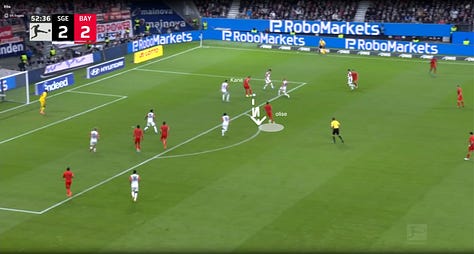
In the Champions League match against Barcelona, Bayern struggled a bit with building play from the back—first due to the opponent’s excellent pressing, and second because of the absence of Pavlović and Musiala. However, Kompany found a solution by dropping Kane into midfield to help progress the ball and distribute play, where the Englishman delivered a masterpiece against one of the best teams in the world.
Kane dropped back to provide a solution for Gnabry to build out from the back because Kimmich was being tightly marked by Fermn. Here, we see Barcelona's excellent pressing and the intelligence of their players—Fermin positions himself behind Kimmich and moves toward Kane to block the passing lane, with Casado following him. Lewandowski also prevents the ball from reaching Kimmich. It was a very successful press that closed all passing options. But in the second image, we witness Kane’s brilliance: with a brilliant first touch, he changes the direction of his body, moves into the open space, and then delivers a wonderful, typical pass toward Laimer, breaking Barcelona’s press.

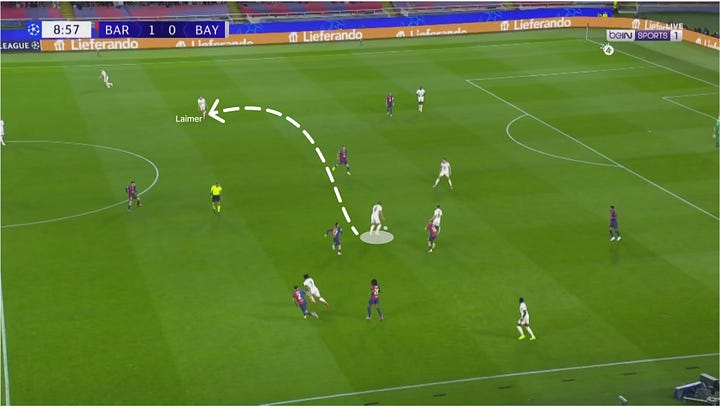
The creativity didn’t stop in this match, as Kane played the team’s first pass that nearly led to a Bayern goal—if not for Guerrero’s carelessness right in front of the goal.
Harry Kane stands far ahead of the nearest striker in terms of playmaking, and this image is the perfect example. As usual, he’s positioned in the middle of the pitch preparing to make a pass. What the average mind sees versus what Kane’s mind envisions is very different. If I showed you the image without the passing lines, you’d think Kane was going to pass to Gnabry, who would then be caught offside and fall into Martinez and Cobarsi’s trap. that’s the small-minded people view. Creative minds operate beyond the ordinary, and Kane delivers a magical pass out wide to Davies, who sprints behind Kounde—who remains stunned by the pass—breaking Barcelona’s offside trap completely. And since Gnabry lacks even a quarter of his team's striker attacking intelligence, the ball passes harmlessly past Barcelona.

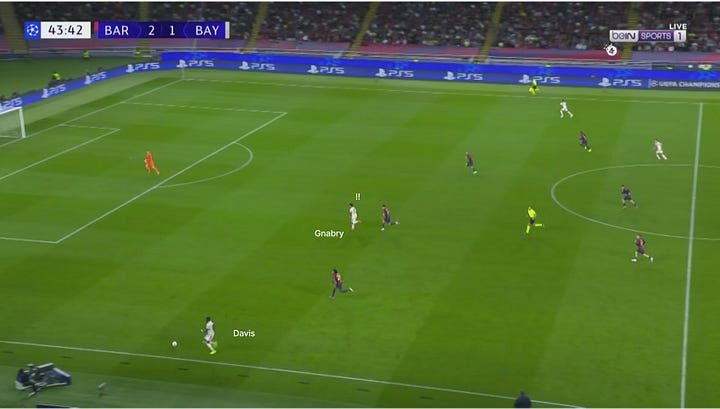
Welcome to the offside trap in Harry Kane’s trap. Flick probably knows better than anyone that Harry Kane possesses exceptional intelligence as a striker, so he advised Kounde to closely mark Kane to prevent him from escaping the trap — and that’s exactly what happened in this scene. Spalletti taught us all a new trick: he said that a striker should always use the linesman as a reference for his movement. By watching the linesman, the striker can get the most crucial information about the position of the last defender, since the linesman will always stay aligned with the last defender. Therefore, the striker doesn’t need to turn around to see what’s behind him; by glancing at the linesman, he will know the perfect moment to make a run and request the ball in behind the defense.
By scoring and assisting last week against Leverkusen in the Champions League, Harry Kane has contributed to 94 goals since the start of last season, making him the top player in Europe. He continues to break individual records that, if listed, would probably make this article never-ending. Kane keeps leading Bayern in big matches, and despite Bayern being out of the DFB-Pokal cup this season and the surprising loss to Bochum that brought Leverkusen closer, Bayern is still the favorite for the Bundesliga title and is in the Champions League quarterfinals. Finally, this could be the Englishman’s harvest season and his crowning with a title in his illustrious career.
Summary:
Harry Kane is a complete striker—complete in a frightening way—with possibly no weaknesses. Kane scores from all positions, both easy and difficult. He uses all parts of his body to finish with the same quality, scoring with both his strong and weak foot equally effectively, and scoring with his head, whether from a bicycle kick or in the air. He possesses incredible shooting accuracy, excels at long-range shots and hitting the post, and is an excellent penalty taker with a success rate above 88% (100% with Bayern). He moves intelligently for crosses and attacks spaces with impressive quality. He participates in different phases of play and links up the lines, contributes to build-up play, and creates chances. He exploits his body positioning in the best way, adapting his style depending on the context. A skilled dribbler, he uses feints and shoulder movements in his dribbling. Sometimes, he positions himself outside central playing areas to enable his teammates to score. He is an elite passer, providing key passes and short or long through balls, diagonal or ground passes, with either the inside or outside of his foot. He defends and presses well, working tirelessly. He understands the game and adapts perfectly to every situation. If you want a striker who only scores, he can do that; if you want one who participates in all phases of play, he excels; and if you want one with complex roles, he is capable. Therefore, he is one of the most complete players in history.
Harry Kane’s 100th match for England
Moreover, he is a great leader and a remarkable personality — a professional and beloved man with very few detractors. Even many Arsenal fans appreciate and love him. He is a calm and composed person who rarely gets into conflicts with other players, a truly respectful man in every sense. A Tottenham fan said something very beautiful about Harry Kane:
"Harry Kane is one of the greatest strikers of this generation. He is a first-class human being, married to his childhood sweetheart, donates to and supports many charitable organizations, and has never been involved in any disputes. He is a perfect role model."
Even Tuchel praised his character and professionalism, saying:
"He is important in the dressing room and on the pitch because of his personality, professionalism, seriousness in training, and how after a loss, he was the first to go down to the field to train with the reserves."
A source close to the dressing room, who spoke on the condition of anonymity to protect their relationship, says team-mates are “in awe of Kane: he combines unshakable self-confidence with genuine humility.”
Lewandowski, the source adds, was just as important for the team in terms of his goals. “But you always got the sense he’s doing it for himself, not the club. For Kane, it’s all about the team winning. He’s the perfect role model for everyone else with that kind of attitude.”
Another staff member describes him as “incredibly nice and easy-going”. Kane, he says, never turns down a fan request to pose for selfies or a signed shirt, and doesn’t mind doing a dozen post-match interviews for TV rights holders every single week.(21)
Even Kompany praised his high professionalism “It’s beneficial to have an outstanding player who is eager to run and fight for the team as a young player. I played against him as an opponent, and he has only improved with age. He has a way of elevating his performance. I trust his consistency and his ability to develop his game, and with such quality, you always get your special moments.”
In conclusion, football is a team sports, starting from the goalkeeper, standing all the way up to the forwards, as well as the coach, technical staff, administrative and medical teams, data analysis and performance departments, nutrition specialists, and even the ground staff. Winning a title is not in the hands of a single player or coach; rather, it is the result of tremendous work by all parties involved. It is true that winning a title is a good achievement for a player as it reflects the efforts of the season, but even without it, nothing really changes because value and quality outweigh trophies. How many of you know Coman titles? Or how many titles Salah has won? Danilo, Marquinhos, Lewandowski… You wouldn’t know offhand unless you sneak a Google search because you simply don’t care. So why are you stuck on Harry Kane? Perhaps in tennis, our champion would be competing with Federer, Djokovic, and Nadal, or in boxing, he would be close to Ali and Tyson; in karate or athletics, he’d win gold enough to disturb Michael phelps throne. But here in football, the trophy means the whole group. Therefore, winning is not a measure of the quality of the coach or the player.
He may win a title this season or even a World Cup later… but for me, that does not add to his legacy because Harry Kane has always been and remains the best and most enjoyable striker I have ever watched, even without trophy. I am not old enough to have seen Shearer, Ronaldo, or Van Basten. I am too young to have heard Gerd Muller or Romario’s voice. The older generations may blame me for that. But I have seen Harry Kane play, and I will talk about it for a long time… Perhaps one of football’s wonders is to have the best striker in football without a title. But what titles could we possibly be talking about in the presence of this giant, Hey prince? Your judgment has been fair even they say that your kingdom lacks the sun to shine at night!
Sources:
1) Harry Kane all Goals in 2016/2017 Season
2)https://www.youtube.com/watch?v=D2XYuR9V94k&t=222s_Nouman channel_
7)https://www.premierleague.com/stats/top/players/big_chance_created
8)https://www.statmuse.com/fc/ask/robert-lewandowski-most-big-chances-created-in-a-season
10)https://www.facebook.com/share/p/14L4KG5F4VL/--Mohamed M. Salah--
11)https://www.premierleague.com/stats/top/players/big_chance_created
12)https://www.statmuse.com/fc/ask/benzema-career-big-chances-created
13)https://fbref.com/en/players/21a66f6a/scout/1710/Harry-Kane-Scouting-Report
14)https://fbref.com/en/players/21a66f6a/scout/1711/Harry-Kane-Scouting-Report
16)Same source as the previous one
17)https://fbref.com/en/players/21a66f6a/scout/11566/Harry-Kane-Scouting-Report
18)https://understat.com/player/647
20)https://fbref.com/en/players/21a66f6a/scout/12212/Harry-Kane-Scouting-Report
Video clips of his finishing and passes, if you’d like to watch:

